Management Of Innovation And Entrepreneurship
VerifiedAdded on 2022/08/12
|21
|5647
|27
AI Summary
Please write a assignment as per the Task Guidelines referencing 30 articles including the ones attached
Contribute Materials
Your contribution can guide someone’s learning journey. Share your
documents today.
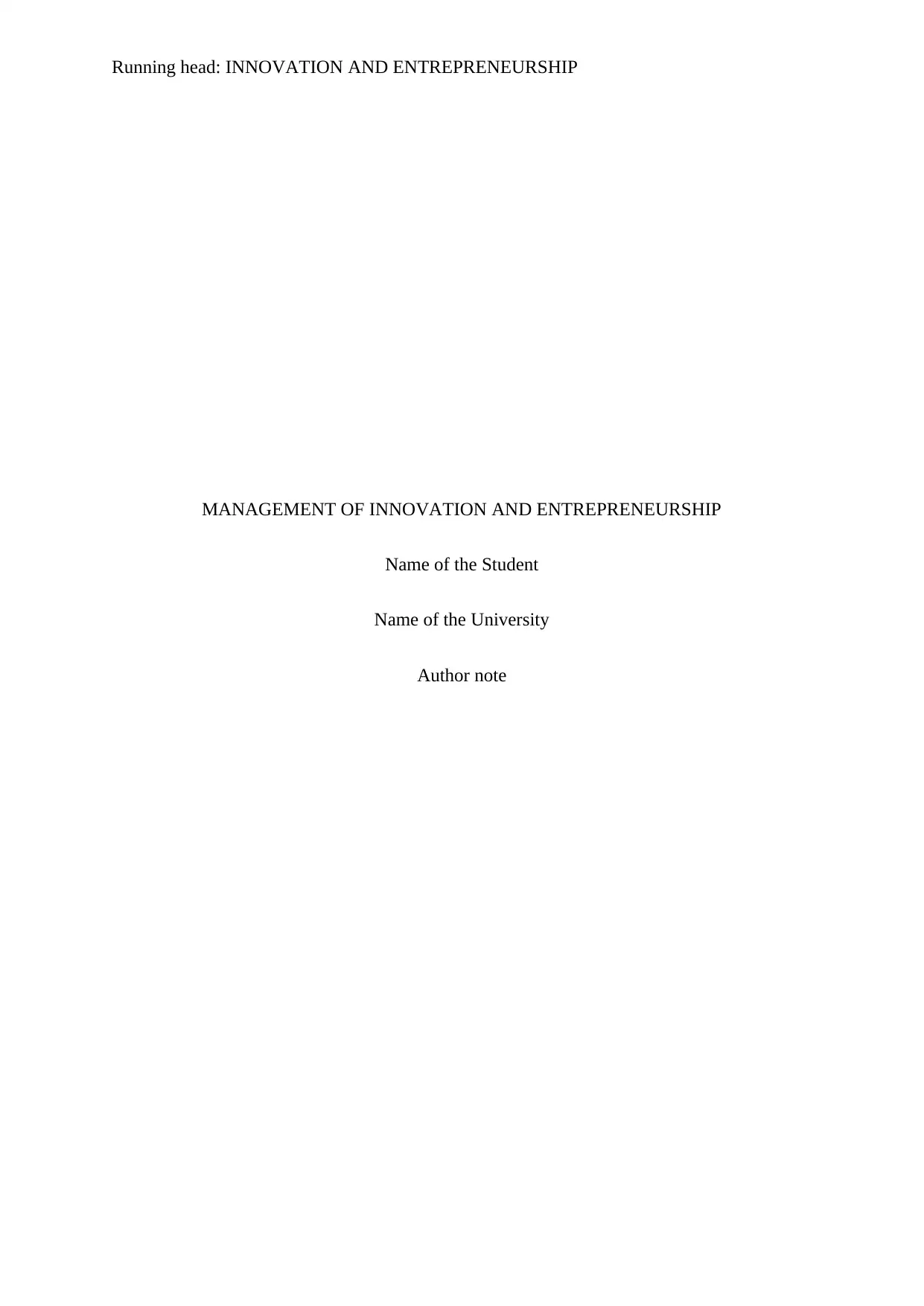
Running head: INNOVATION AND ENTREPRENEURSHIP
MANAGEMENT OF INNOVATION AND ENTREPRENEURSHIP
Name of the Student
Name of the University
Author note
MANAGEMENT OF INNOVATION AND ENTREPRENEURSHIP
Name of the Student
Name of the University
Author note
Secure Best Marks with AI Grader
Need help grading? Try our AI Grader for instant feedback on your assignments.
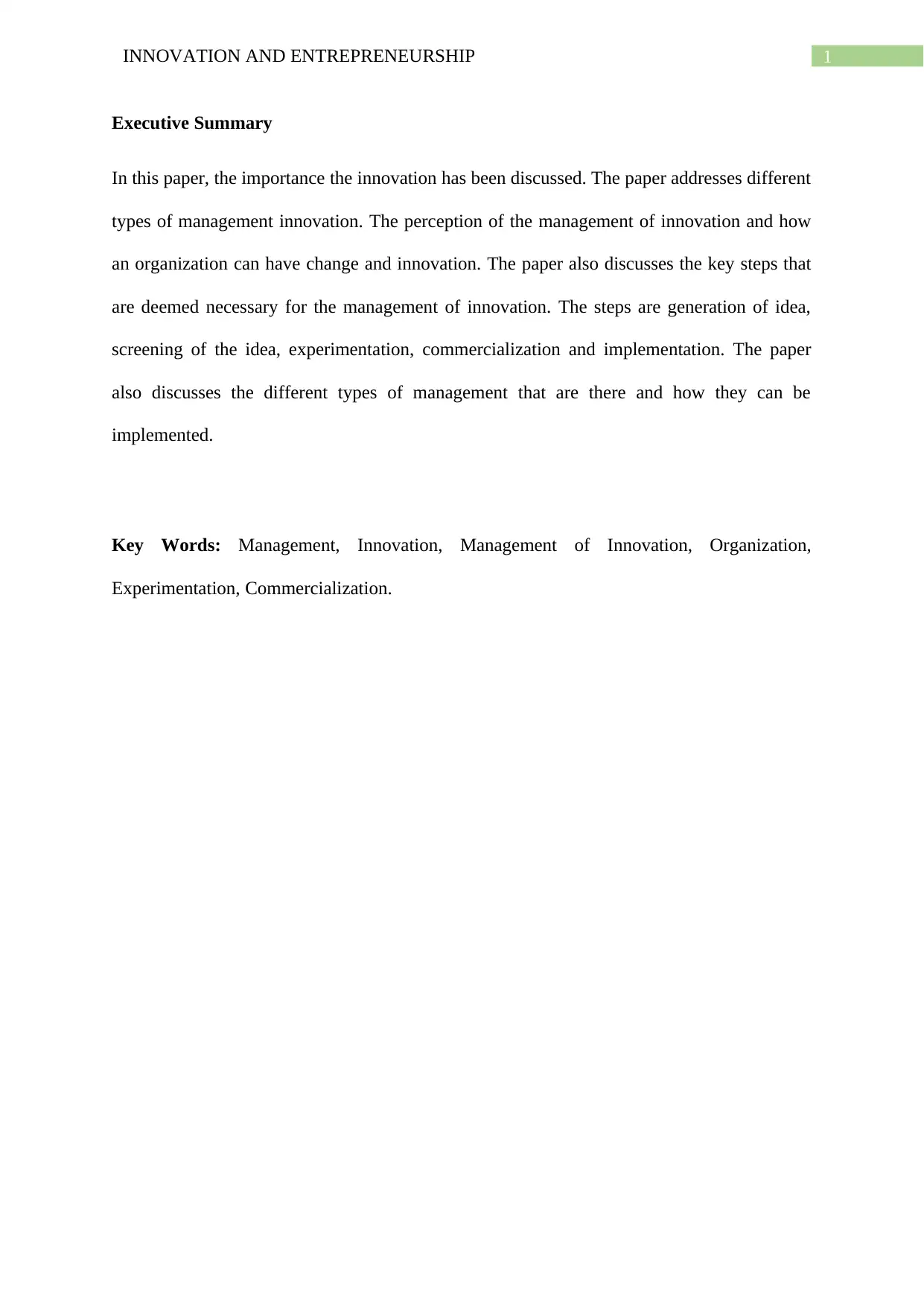
1INNOVATION AND ENTREPRENEURSHIP
Executive Summary
In this paper, the importance the innovation has been discussed. The paper addresses different
types of management innovation. The perception of the management of innovation and how
an organization can have change and innovation. The paper also discusses the key steps that
are deemed necessary for the management of innovation. The steps are generation of idea,
screening of the idea, experimentation, commercialization and implementation. The paper
also discusses the different types of management that are there and how they can be
implemented.
Key Words: Management, Innovation, Management of Innovation, Organization,
Experimentation, Commercialization.
Executive Summary
In this paper, the importance the innovation has been discussed. The paper addresses different
types of management innovation. The perception of the management of innovation and how
an organization can have change and innovation. The paper also discusses the key steps that
are deemed necessary for the management of innovation. The steps are generation of idea,
screening of the idea, experimentation, commercialization and implementation. The paper
also discusses the different types of management that are there and how they can be
implemented.
Key Words: Management, Innovation, Management of Innovation, Organization,
Experimentation, Commercialization.
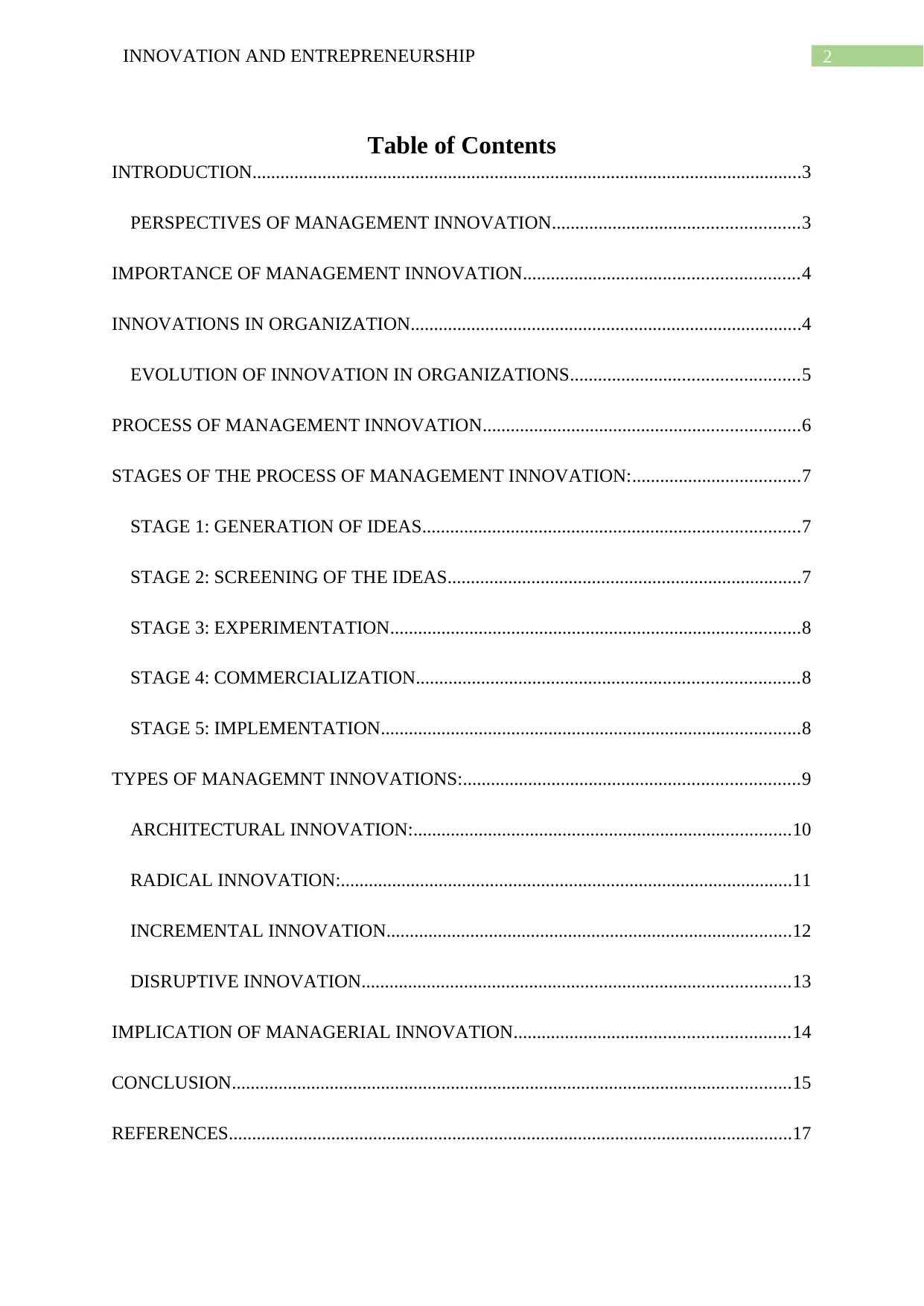
2INNOVATION AND ENTREPRENEURSHIP
Table of Contents
INTRODUCTION......................................................................................................................3
PERSPECTIVES OF MANAGEMENT INNOVATION.....................................................3
IMPORTANCE OF MANAGEMENT INNOVATION...........................................................4
INNOVATIONS IN ORGANIZATION....................................................................................4
EVOLUTION OF INNOVATION IN ORGANIZATIONS.................................................5
PROCESS OF MANAGEMENT INNOVATION....................................................................6
STAGES OF THE PROCESS OF MANAGEMENT INNOVATION:....................................7
STAGE 1: GENERATION OF IDEAS.................................................................................7
STAGE 2: SCREENING OF THE IDEAS............................................................................7
STAGE 3: EXPERIMENTATION........................................................................................8
STAGE 4: COMMERCIALIZATION..................................................................................8
STAGE 5: IMPLEMENTATION..........................................................................................8
TYPES OF MANAGEMNT INNOVATIONS:........................................................................9
ARCHITECTURAL INNOVATION:.................................................................................10
RADICAL INNOVATION:.................................................................................................11
INCREMENTAL INNOVATION.......................................................................................12
DISRUPTIVE INNOVATION............................................................................................13
IMPLICATION OF MANAGERIAL INNOVATION...........................................................14
CONCLUSION........................................................................................................................15
REFERENCES.........................................................................................................................17
Table of Contents
INTRODUCTION......................................................................................................................3
PERSPECTIVES OF MANAGEMENT INNOVATION.....................................................3
IMPORTANCE OF MANAGEMENT INNOVATION...........................................................4
INNOVATIONS IN ORGANIZATION....................................................................................4
EVOLUTION OF INNOVATION IN ORGANIZATIONS.................................................5
PROCESS OF MANAGEMENT INNOVATION....................................................................6
STAGES OF THE PROCESS OF MANAGEMENT INNOVATION:....................................7
STAGE 1: GENERATION OF IDEAS.................................................................................7
STAGE 2: SCREENING OF THE IDEAS............................................................................7
STAGE 3: EXPERIMENTATION........................................................................................8
STAGE 4: COMMERCIALIZATION..................................................................................8
STAGE 5: IMPLEMENTATION..........................................................................................8
TYPES OF MANAGEMNT INNOVATIONS:........................................................................9
ARCHITECTURAL INNOVATION:.................................................................................10
RADICAL INNOVATION:.................................................................................................11
INCREMENTAL INNOVATION.......................................................................................12
DISRUPTIVE INNOVATION............................................................................................13
IMPLICATION OF MANAGERIAL INNOVATION...........................................................14
CONCLUSION........................................................................................................................15
REFERENCES.........................................................................................................................17
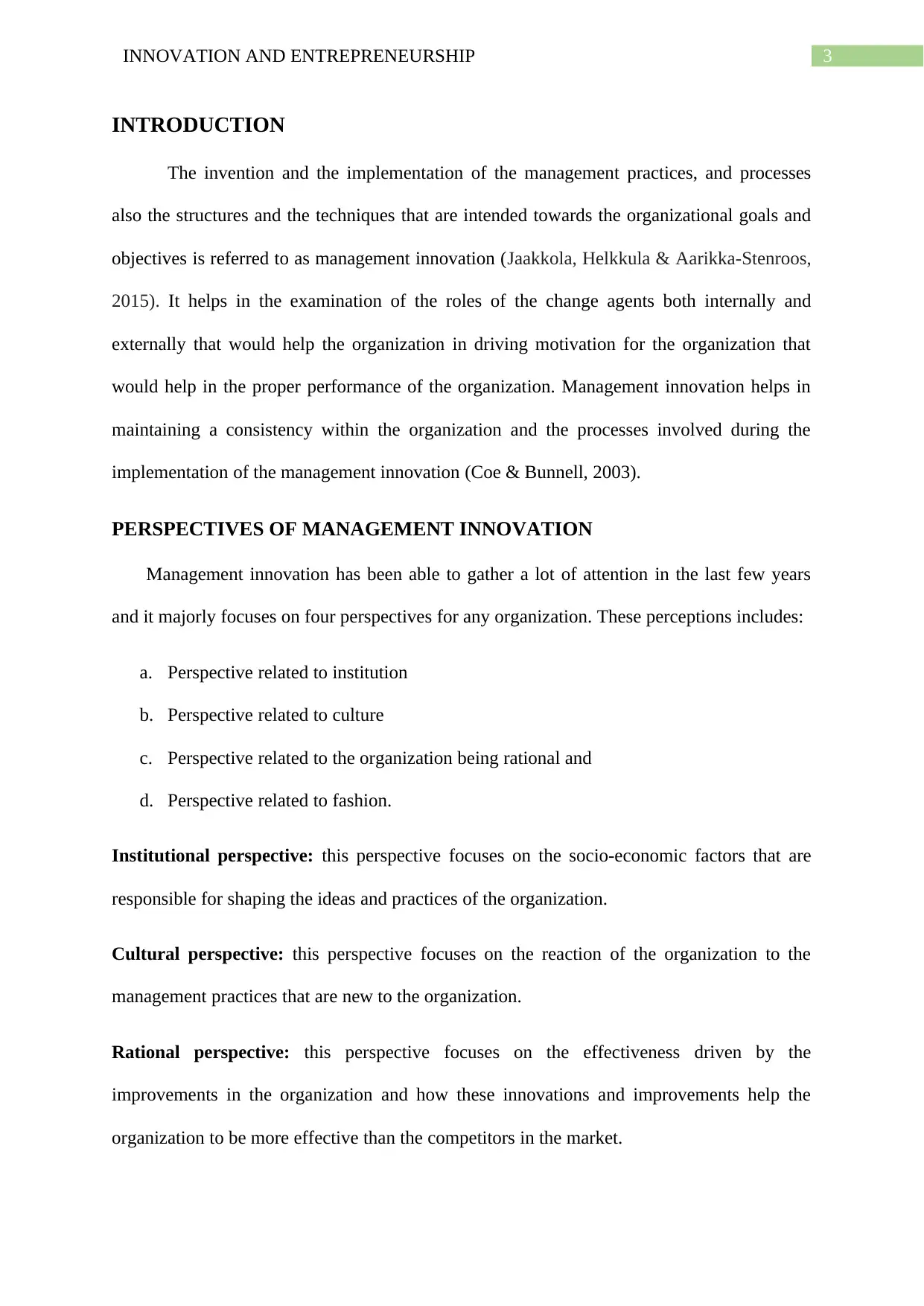
3INNOVATION AND ENTREPRENEURSHIP
INTRODUCTION
The invention and the implementation of the management practices, and processes
also the structures and the techniques that are intended towards the organizational goals and
objectives is referred to as management innovation (Jaakkola, Helkkula & Aarikka-Stenroos,
2015). It helps in the examination of the roles of the change agents both internally and
externally that would help the organization in driving motivation for the organization that
would help in the proper performance of the organization. Management innovation helps in
maintaining a consistency within the organization and the processes involved during the
implementation of the management innovation (Coe & Bunnell, 2003).
PERSPECTIVES OF MANAGEMENT INNOVATION
Management innovation has been able to gather a lot of attention in the last few years
and it majorly focuses on four perspectives for any organization. These perceptions includes:
a. Perspective related to institution
b. Perspective related to culture
c. Perspective related to the organization being rational and
d. Perspective related to fashion.
Institutional perspective: this perspective focuses on the socio-economic factors that are
responsible for shaping the ideas and practices of the organization.
Cultural perspective: this perspective focuses on the reaction of the organization to the
management practices that are new to the organization.
Rational perspective: this perspective focuses on the effectiveness driven by the
improvements in the organization and how these innovations and improvements help the
organization to be more effective than the competitors in the market.
INTRODUCTION
The invention and the implementation of the management practices, and processes
also the structures and the techniques that are intended towards the organizational goals and
objectives is referred to as management innovation (Jaakkola, Helkkula & Aarikka-Stenroos,
2015). It helps in the examination of the roles of the change agents both internally and
externally that would help the organization in driving motivation for the organization that
would help in the proper performance of the organization. Management innovation helps in
maintaining a consistency within the organization and the processes involved during the
implementation of the management innovation (Coe & Bunnell, 2003).
PERSPECTIVES OF MANAGEMENT INNOVATION
Management innovation has been able to gather a lot of attention in the last few years
and it majorly focuses on four perspectives for any organization. These perceptions includes:
a. Perspective related to institution
b. Perspective related to culture
c. Perspective related to the organization being rational and
d. Perspective related to fashion.
Institutional perspective: this perspective focuses on the socio-economic factors that are
responsible for shaping the ideas and practices of the organization.
Cultural perspective: this perspective focuses on the reaction of the organization to the
management practices that are new to the organization.
Rational perspective: this perspective focuses on the effectiveness driven by the
improvements in the organization and how these innovations and improvements help the
organization to be more effective than the competitors in the market.
Secure Best Marks with AI Grader
Need help grading? Try our AI Grader for instant feedback on your assignments.
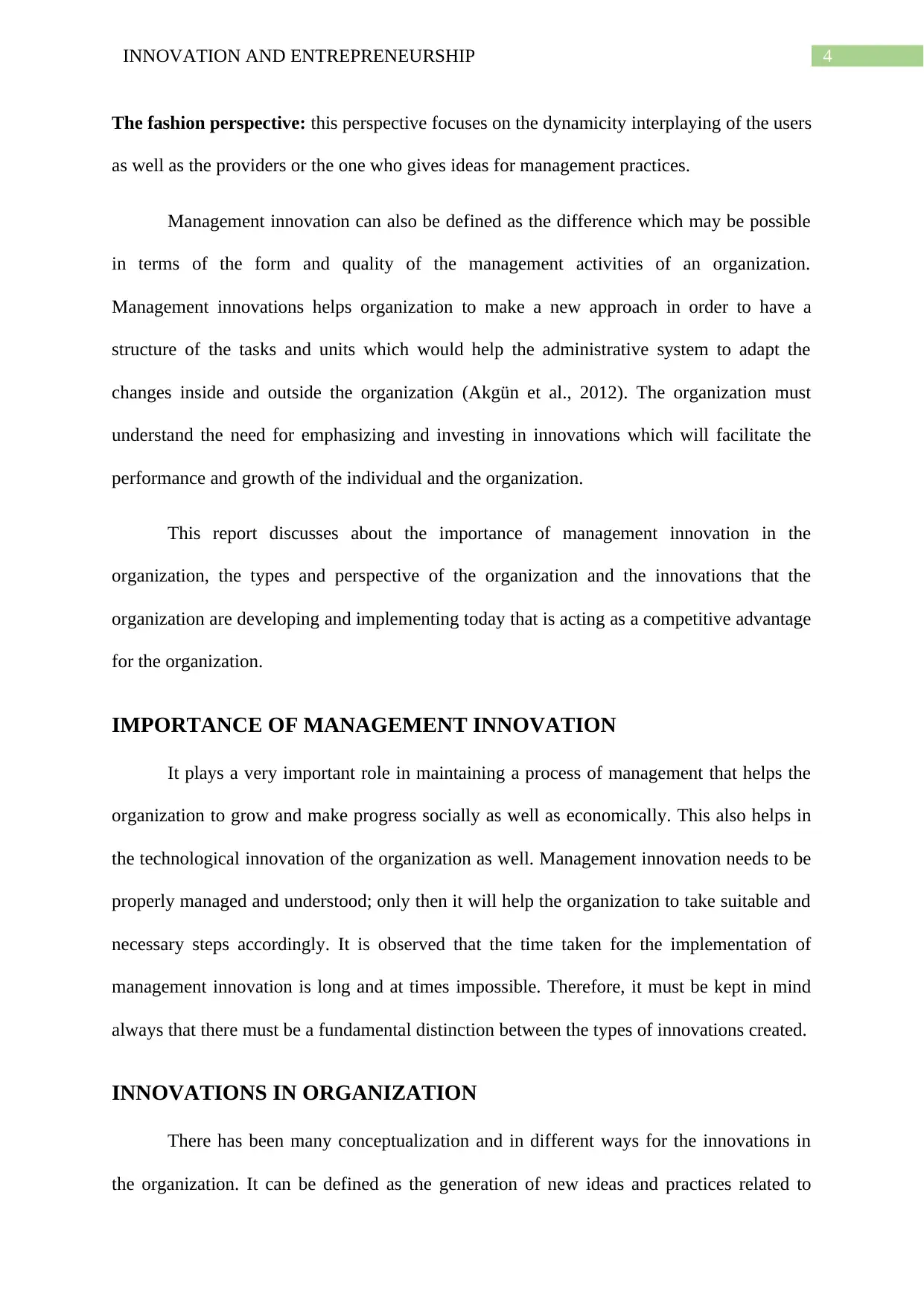
4INNOVATION AND ENTREPRENEURSHIP
The fashion perspective: this perspective focuses on the dynamicity interplaying of the users
as well as the providers or the one who gives ideas for management practices.
Management innovation can also be defined as the difference which may be possible
in terms of the form and quality of the management activities of an organization.
Management innovations helps organization to make a new approach in order to have a
structure of the tasks and units which would help the administrative system to adapt the
changes inside and outside the organization (Akgün et al., 2012). The organization must
understand the need for emphasizing and investing in innovations which will facilitate the
performance and growth of the individual and the organization.
This report discusses about the importance of management innovation in the
organization, the types and perspective of the organization and the innovations that the
organization are developing and implementing today that is acting as a competitive advantage
for the organization.
IMPORTANCE OF MANAGEMENT INNOVATION
It plays a very important role in maintaining a process of management that helps the
organization to grow and make progress socially as well as economically. This also helps in
the technological innovation of the organization as well. Management innovation needs to be
properly managed and understood; only then it will help the organization to take suitable and
necessary steps accordingly. It is observed that the time taken for the implementation of
management innovation is long and at times impossible. Therefore, it must be kept in mind
always that there must be a fundamental distinction between the types of innovations created.
INNOVATIONS IN ORGANIZATION
There has been many conceptualization and in different ways for the innovations in
the organization. It can be defined as the generation of new ideas and practices related to
The fashion perspective: this perspective focuses on the dynamicity interplaying of the users
as well as the providers or the one who gives ideas for management practices.
Management innovation can also be defined as the difference which may be possible
in terms of the form and quality of the management activities of an organization.
Management innovations helps organization to make a new approach in order to have a
structure of the tasks and units which would help the administrative system to adapt the
changes inside and outside the organization (Akgün et al., 2012). The organization must
understand the need for emphasizing and investing in innovations which will facilitate the
performance and growth of the individual and the organization.
This report discusses about the importance of management innovation in the
organization, the types and perspective of the organization and the innovations that the
organization are developing and implementing today that is acting as a competitive advantage
for the organization.
IMPORTANCE OF MANAGEMENT INNOVATION
It plays a very important role in maintaining a process of management that helps the
organization to grow and make progress socially as well as economically. This also helps in
the technological innovation of the organization as well. Management innovation needs to be
properly managed and understood; only then it will help the organization to take suitable and
necessary steps accordingly. It is observed that the time taken for the implementation of
management innovation is long and at times impossible. Therefore, it must be kept in mind
always that there must be a fundamental distinction between the types of innovations created.
INNOVATIONS IN ORGANIZATION
There has been many conceptualization and in different ways for the innovations in
the organization. It can be defined as the generation of new ideas and practices related to
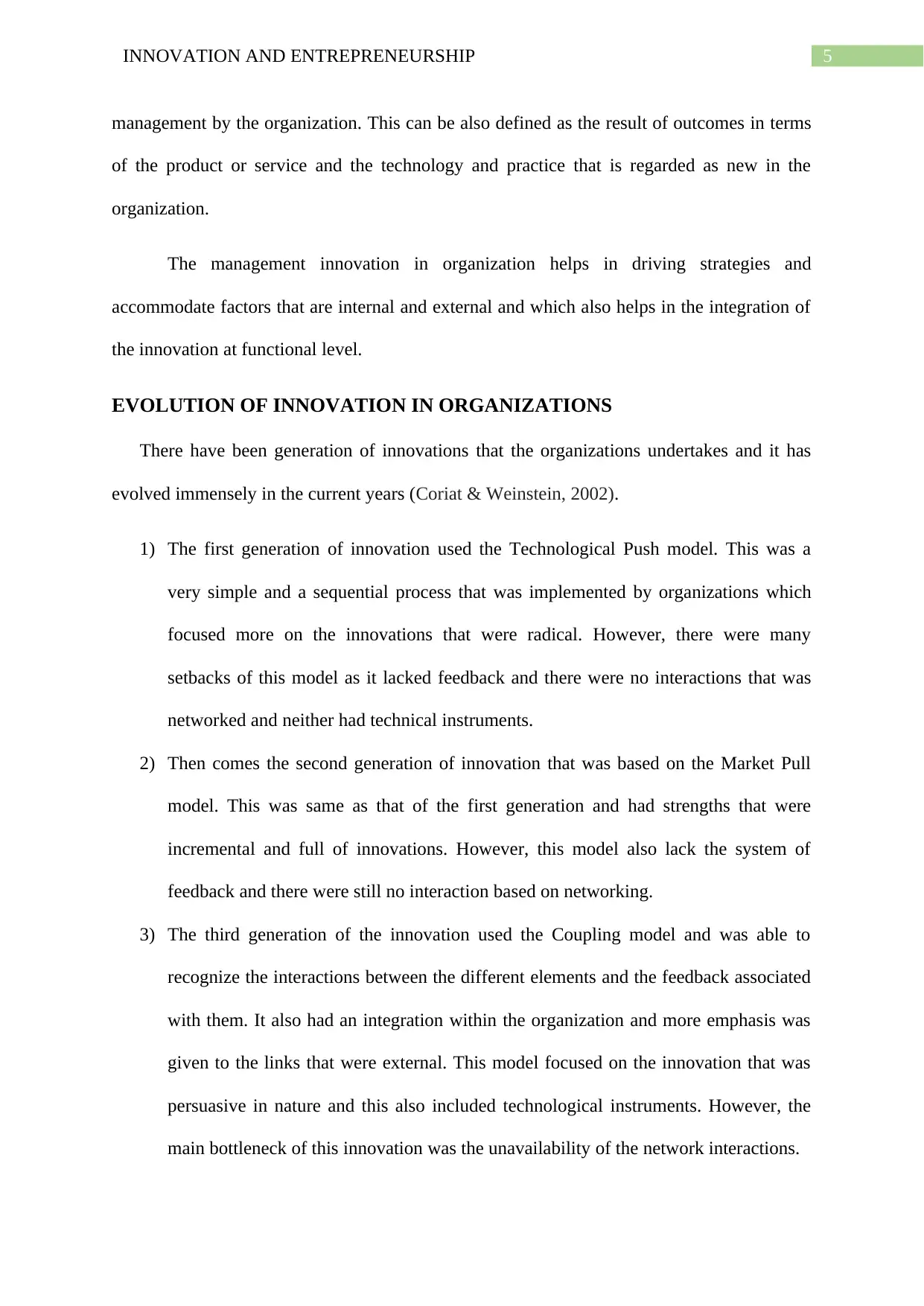
5INNOVATION AND ENTREPRENEURSHIP
management by the organization. This can be also defined as the result of outcomes in terms
of the product or service and the technology and practice that is regarded as new in the
organization.
The management innovation in organization helps in driving strategies and
accommodate factors that are internal and external and which also helps in the integration of
the innovation at functional level.
EVOLUTION OF INNOVATION IN ORGANIZATIONS
There have been generation of innovations that the organizations undertakes and it has
evolved immensely in the current years (Coriat & Weinstein, 2002).
1) The first generation of innovation used the Technological Push model. This was a
very simple and a sequential process that was implemented by organizations which
focused more on the innovations that were radical. However, there were many
setbacks of this model as it lacked feedback and there were no interactions that was
networked and neither had technical instruments.
2) Then comes the second generation of innovation that was based on the Market Pull
model. This was same as that of the first generation and had strengths that were
incremental and full of innovations. However, this model also lack the system of
feedback and there were still no interaction based on networking.
3) The third generation of the innovation used the Coupling model and was able to
recognize the interactions between the different elements and the feedback associated
with them. It also had an integration within the organization and more emphasis was
given to the links that were external. This model focused on the innovation that was
persuasive in nature and this also included technological instruments. However, the
main bottleneck of this innovation was the unavailability of the network interactions.
management by the organization. This can be also defined as the result of outcomes in terms
of the product or service and the technology and practice that is regarded as new in the
organization.
The management innovation in organization helps in driving strategies and
accommodate factors that are internal and external and which also helps in the integration of
the innovation at functional level.
EVOLUTION OF INNOVATION IN ORGANIZATIONS
There have been generation of innovations that the organizations undertakes and it has
evolved immensely in the current years (Coriat & Weinstein, 2002).
1) The first generation of innovation used the Technological Push model. This was a
very simple and a sequential process that was implemented by organizations which
focused more on the innovations that were radical. However, there were many
setbacks of this model as it lacked feedback and there were no interactions that was
networked and neither had technical instruments.
2) Then comes the second generation of innovation that was based on the Market Pull
model. This was same as that of the first generation and had strengths that were
incremental and full of innovations. However, this model also lack the system of
feedback and there were still no interaction based on networking.
3) The third generation of the innovation used the Coupling model and was able to
recognize the interactions between the different elements and the feedback associated
with them. It also had an integration within the organization and more emphasis was
given to the links that were external. This model focused on the innovation that was
persuasive in nature and this also included technological instruments. However, the
main bottleneck of this innovation was the unavailability of the network interactions.
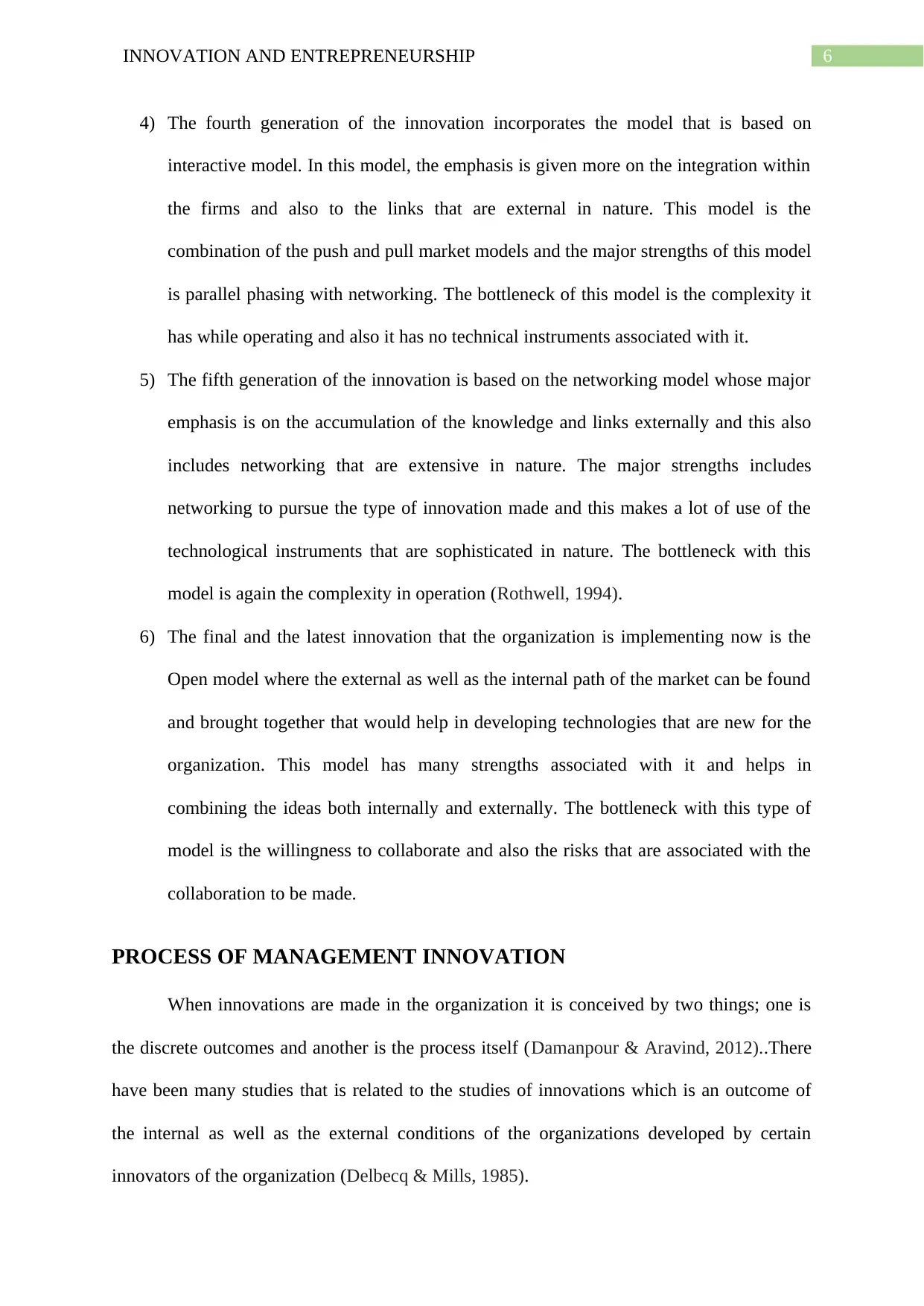
6INNOVATION AND ENTREPRENEURSHIP
4) The fourth generation of the innovation incorporates the model that is based on
interactive model. In this model, the emphasis is given more on the integration within
the firms and also to the links that are external in nature. This model is the
combination of the push and pull market models and the major strengths of this model
is parallel phasing with networking. The bottleneck of this model is the complexity it
has while operating and also it has no technical instruments associated with it.
5) The fifth generation of the innovation is based on the networking model whose major
emphasis is on the accumulation of the knowledge and links externally and this also
includes networking that are extensive in nature. The major strengths includes
networking to pursue the type of innovation made and this makes a lot of use of the
technological instruments that are sophisticated in nature. The bottleneck with this
model is again the complexity in operation (Rothwell, 1994).
6) The final and the latest innovation that the organization is implementing now is the
Open model where the external as well as the internal path of the market can be found
and brought together that would help in developing technologies that are new for the
organization. This model has many strengths associated with it and helps in
combining the ideas both internally and externally. The bottleneck with this type of
model is the willingness to collaborate and also the risks that are associated with the
collaboration to be made.
PROCESS OF MANAGEMENT INNOVATION
When innovations are made in the organization it is conceived by two things; one is
the discrete outcomes and another is the process itself (Damanpour & Aravind, 2012)..There
have been many studies that is related to the studies of innovations which is an outcome of
the internal as well as the external conditions of the organizations developed by certain
innovators of the organization (Delbecq & Mills, 1985).
4) The fourth generation of the innovation incorporates the model that is based on
interactive model. In this model, the emphasis is given more on the integration within
the firms and also to the links that are external in nature. This model is the
combination of the push and pull market models and the major strengths of this model
is parallel phasing with networking. The bottleneck of this model is the complexity it
has while operating and also it has no technical instruments associated with it.
5) The fifth generation of the innovation is based on the networking model whose major
emphasis is on the accumulation of the knowledge and links externally and this also
includes networking that are extensive in nature. The major strengths includes
networking to pursue the type of innovation made and this makes a lot of use of the
technological instruments that are sophisticated in nature. The bottleneck with this
model is again the complexity in operation (Rothwell, 1994).
6) The final and the latest innovation that the organization is implementing now is the
Open model where the external as well as the internal path of the market can be found
and brought together that would help in developing technologies that are new for the
organization. This model has many strengths associated with it and helps in
combining the ideas both internally and externally. The bottleneck with this type of
model is the willingness to collaborate and also the risks that are associated with the
collaboration to be made.
PROCESS OF MANAGEMENT INNOVATION
When innovations are made in the organization it is conceived by two things; one is
the discrete outcomes and another is the process itself (Damanpour & Aravind, 2012)..There
have been many studies that is related to the studies of innovations which is an outcome of
the internal as well as the external conditions of the organizations developed by certain
innovators of the organization (Delbecq & Mills, 1985).
Paraphrase This Document
Need a fresh take? Get an instant paraphrase of this document with our AI Paraphraser
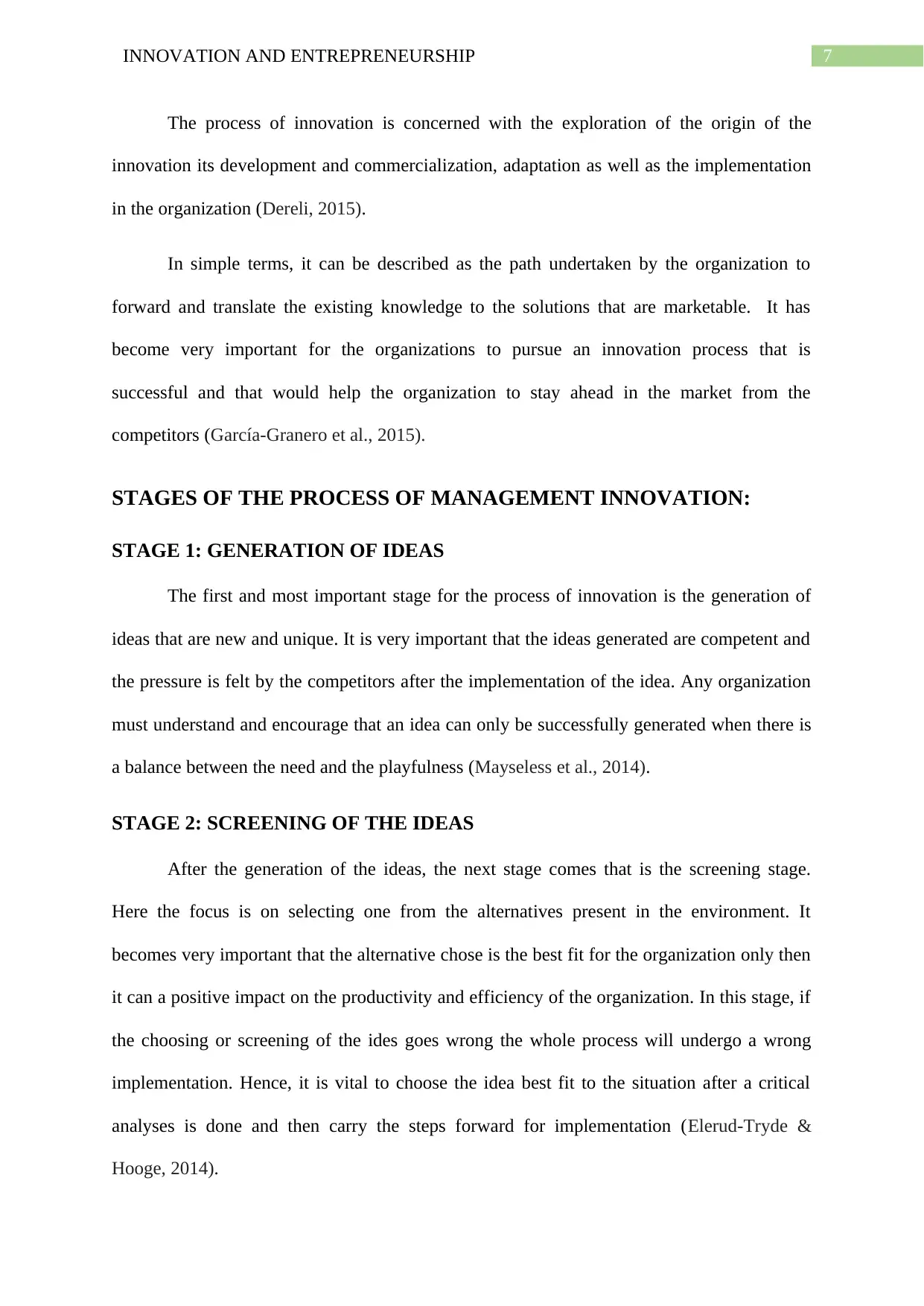
7INNOVATION AND ENTREPRENEURSHIP
The process of innovation is concerned with the exploration of the origin of the
innovation its development and commercialization, adaptation as well as the implementation
in the organization (Dereli, 2015).
In simple terms, it can be described as the path undertaken by the organization to
forward and translate the existing knowledge to the solutions that are marketable. It has
become very important for the organizations to pursue an innovation process that is
successful and that would help the organization to stay ahead in the market from the
competitors (García-Granero et al., 2015).
STAGES OF THE PROCESS OF MANAGEMENT INNOVATION:
STAGE 1: GENERATION OF IDEAS
The first and most important stage for the process of innovation is the generation of
ideas that are new and unique. It is very important that the ideas generated are competent and
the pressure is felt by the competitors after the implementation of the idea. Any organization
must understand and encourage that an idea can only be successfully generated when there is
a balance between the need and the playfulness (Mayseless et al., 2014).
STAGE 2: SCREENING OF THE IDEAS
After the generation of the ideas, the next stage comes that is the screening stage.
Here the focus is on selecting one from the alternatives present in the environment. It
becomes very important that the alternative chose is the best fit for the organization only then
it can a positive impact on the productivity and efficiency of the organization. In this stage, if
the choosing or screening of the ides goes wrong the whole process will undergo a wrong
implementation. Hence, it is vital to choose the idea best fit to the situation after a critical
analyses is done and then carry the steps forward for implementation (Elerud‐Tryde &
Hooge, 2014).
The process of innovation is concerned with the exploration of the origin of the
innovation its development and commercialization, adaptation as well as the implementation
in the organization (Dereli, 2015).
In simple terms, it can be described as the path undertaken by the organization to
forward and translate the existing knowledge to the solutions that are marketable. It has
become very important for the organizations to pursue an innovation process that is
successful and that would help the organization to stay ahead in the market from the
competitors (García-Granero et al., 2015).
STAGES OF THE PROCESS OF MANAGEMENT INNOVATION:
STAGE 1: GENERATION OF IDEAS
The first and most important stage for the process of innovation is the generation of
ideas that are new and unique. It is very important that the ideas generated are competent and
the pressure is felt by the competitors after the implementation of the idea. Any organization
must understand and encourage that an idea can only be successfully generated when there is
a balance between the need and the playfulness (Mayseless et al., 2014).
STAGE 2: SCREENING OF THE IDEAS
After the generation of the ideas, the next stage comes that is the screening stage.
Here the focus is on selecting one from the alternatives present in the environment. It
becomes very important that the alternative chose is the best fit for the organization only then
it can a positive impact on the productivity and efficiency of the organization. In this stage, if
the choosing or screening of the ides goes wrong the whole process will undergo a wrong
implementation. Hence, it is vital to choose the idea best fit to the situation after a critical
analyses is done and then carry the steps forward for implementation (Elerud‐Tryde &
Hooge, 2014).
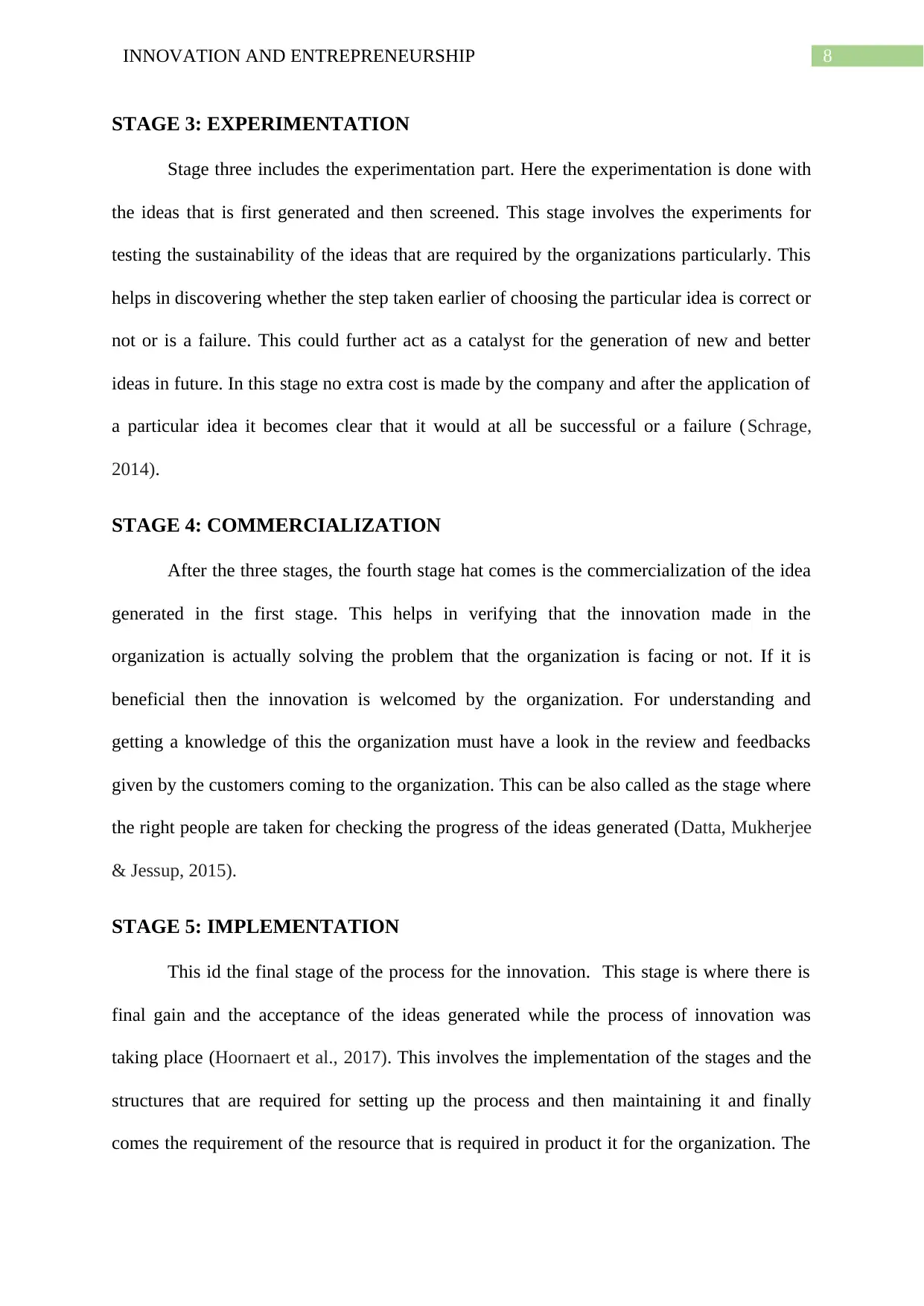
8INNOVATION AND ENTREPRENEURSHIP
STAGE 3: EXPERIMENTATION
Stage three includes the experimentation part. Here the experimentation is done with
the ideas that is first generated and then screened. This stage involves the experiments for
testing the sustainability of the ideas that are required by the organizations particularly. This
helps in discovering whether the step taken earlier of choosing the particular idea is correct or
not or is a failure. This could further act as a catalyst for the generation of new and better
ideas in future. In this stage no extra cost is made by the company and after the application of
a particular idea it becomes clear that it would at all be successful or a failure (Schrage,
2014).
STAGE 4: COMMERCIALIZATION
After the three stages, the fourth stage hat comes is the commercialization of the idea
generated in the first stage. This helps in verifying that the innovation made in the
organization is actually solving the problem that the organization is facing or not. If it is
beneficial then the innovation is welcomed by the organization. For understanding and
getting a knowledge of this the organization must have a look in the review and feedbacks
given by the customers coming to the organization. This can be also called as the stage where
the right people are taken for checking the progress of the ideas generated (Datta, Mukherjee
& Jessup, 2015).
STAGE 5: IMPLEMENTATION
This id the final stage of the process for the innovation. This stage is where there is
final gain and the acceptance of the ideas generated while the process of innovation was
taking place (Hoornaert et al., 2017). This involves the implementation of the stages and the
structures that are required for setting up the process and then maintaining it and finally
comes the requirement of the resource that is required in product it for the organization. The
STAGE 3: EXPERIMENTATION
Stage three includes the experimentation part. Here the experimentation is done with
the ideas that is first generated and then screened. This stage involves the experiments for
testing the sustainability of the ideas that are required by the organizations particularly. This
helps in discovering whether the step taken earlier of choosing the particular idea is correct or
not or is a failure. This could further act as a catalyst for the generation of new and better
ideas in future. In this stage no extra cost is made by the company and after the application of
a particular idea it becomes clear that it would at all be successful or a failure (Schrage,
2014).
STAGE 4: COMMERCIALIZATION
After the three stages, the fourth stage hat comes is the commercialization of the idea
generated in the first stage. This helps in verifying that the innovation made in the
organization is actually solving the problem that the organization is facing or not. If it is
beneficial then the innovation is welcomed by the organization. For understanding and
getting a knowledge of this the organization must have a look in the review and feedbacks
given by the customers coming to the organization. This can be also called as the stage where
the right people are taken for checking the progress of the ideas generated (Datta, Mukherjee
& Jessup, 2015).
STAGE 5: IMPLEMENTATION
This id the final stage of the process for the innovation. This stage is where there is
final gain and the acceptance of the ideas generated while the process of innovation was
taking place (Hoornaert et al., 2017). This involves the implementation of the stages and the
structures that are required for setting up the process and then maintaining it and finally
comes the requirement of the resource that is required in product it for the organization. The
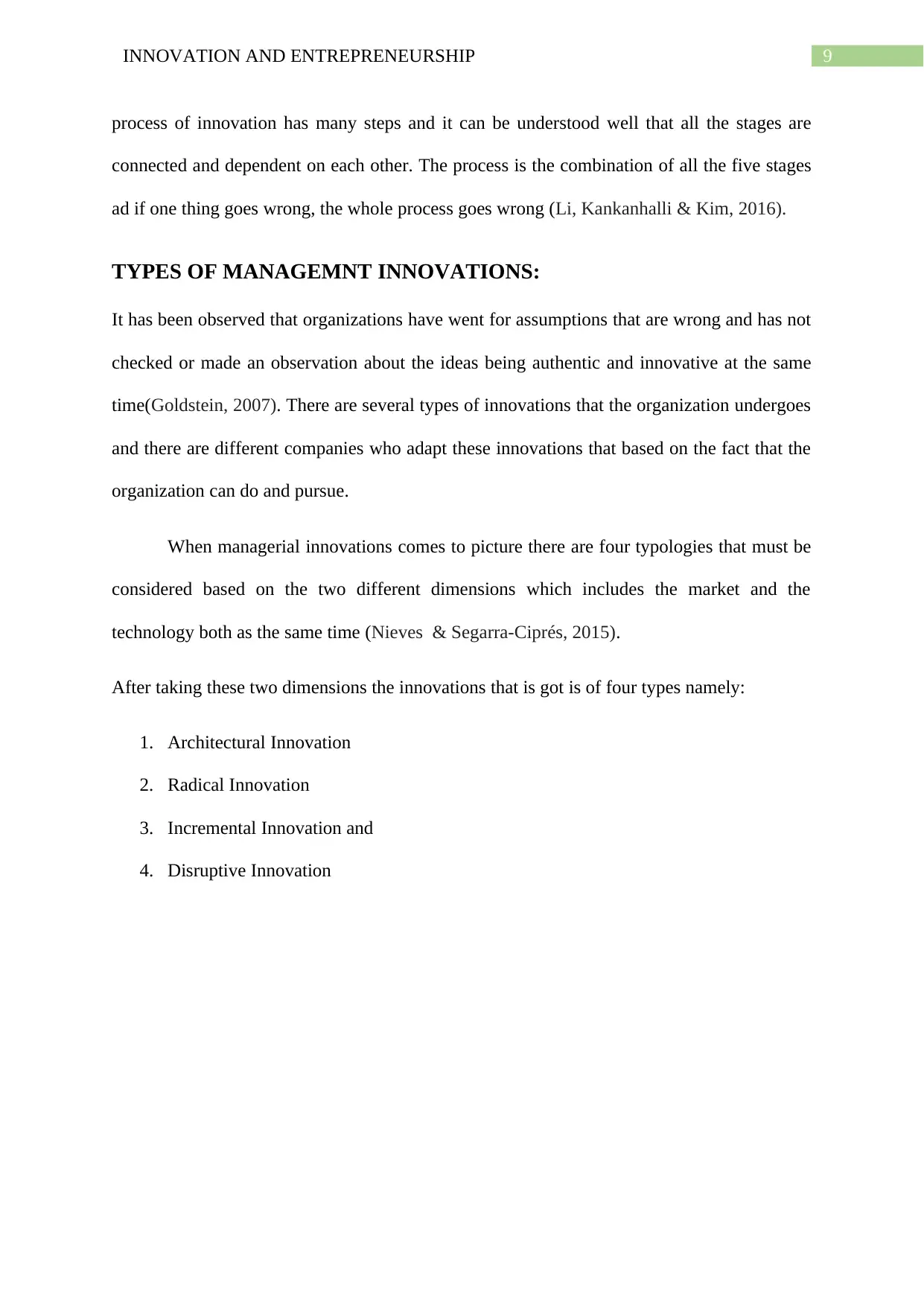
9INNOVATION AND ENTREPRENEURSHIP
process of innovation has many steps and it can be understood well that all the stages are
connected and dependent on each other. The process is the combination of all the five stages
ad if one thing goes wrong, the whole process goes wrong (Li, Kankanhalli & Kim, 2016).
TYPES OF MANAGEMNT INNOVATIONS:
It has been observed that organizations have went for assumptions that are wrong and has not
checked or made an observation about the ideas being authentic and innovative at the same
time(Goldstein, 2007). There are several types of innovations that the organization undergoes
and there are different companies who adapt these innovations that based on the fact that the
organization can do and pursue.
When managerial innovations comes to picture there are four typologies that must be
considered based on the two different dimensions which includes the market and the
technology both as the same time (Nieves & Segarra-Ciprés, 2015).
After taking these two dimensions the innovations that is got is of four types namely:
1. Architectural Innovation
2. Radical Innovation
3. Incremental Innovation and
4. Disruptive Innovation
process of innovation has many steps and it can be understood well that all the stages are
connected and dependent on each other. The process is the combination of all the five stages
ad if one thing goes wrong, the whole process goes wrong (Li, Kankanhalli & Kim, 2016).
TYPES OF MANAGEMNT INNOVATIONS:
It has been observed that organizations have went for assumptions that are wrong and has not
checked or made an observation about the ideas being authentic and innovative at the same
time(Goldstein, 2007). There are several types of innovations that the organization undergoes
and there are different companies who adapt these innovations that based on the fact that the
organization can do and pursue.
When managerial innovations comes to picture there are four typologies that must be
considered based on the two different dimensions which includes the market and the
technology both as the same time (Nieves & Segarra-Ciprés, 2015).
After taking these two dimensions the innovations that is got is of four types namely:
1. Architectural Innovation
2. Radical Innovation
3. Incremental Innovation and
4. Disruptive Innovation
Secure Best Marks with AI Grader
Need help grading? Try our AI Grader for instant feedback on your assignments.
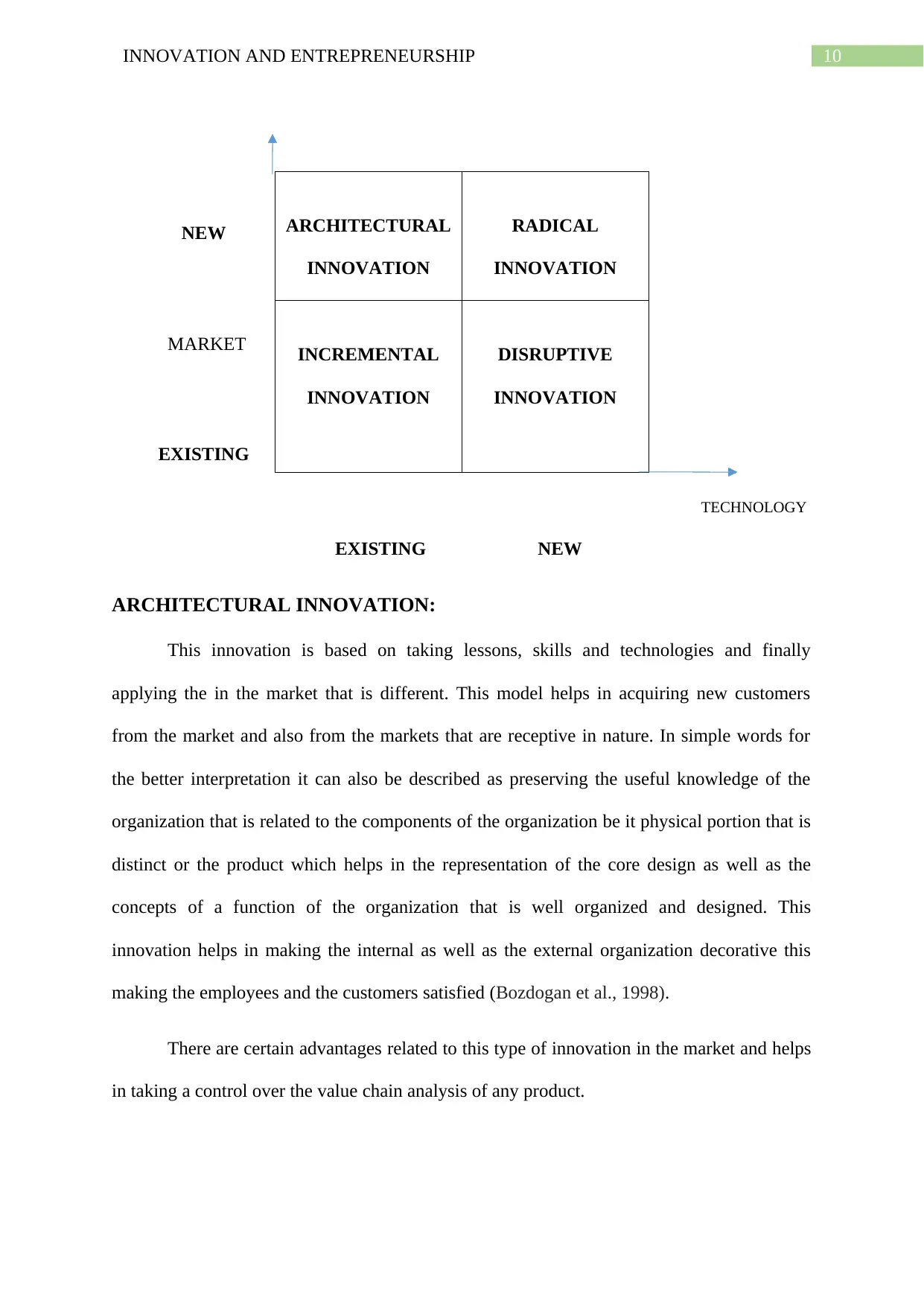
10INNOVATION AND ENTREPRENEURSHIP
NEW
MARKET
EXISTING
TECHNOLOGY
EXISTING NEW
ARCHITECTURAL INNOVATION:
This innovation is based on taking lessons, skills and technologies and finally
applying the in the market that is different. This model helps in acquiring new customers
from the market and also from the markets that are receptive in nature. In simple words for
the better interpretation it can also be described as preserving the useful knowledge of the
organization that is related to the components of the organization be it physical portion that is
distinct or the product which helps in the representation of the core design as well as the
concepts of a function of the organization that is well organized and designed. This
innovation helps in making the internal as well as the external organization decorative this
making the employees and the customers satisfied (Bozdogan et al., 1998).
There are certain advantages related to this type of innovation in the market and helps
in taking a control over the value chain analysis of any product.
ARCHITECTURAL
INNOVATION
RADICAL
INNOVATION
INCREMENTAL
INNOVATION
DISRUPTIVE
INNOVATION
NEW
MARKET
EXISTING
TECHNOLOGY
EXISTING NEW
ARCHITECTURAL INNOVATION:
This innovation is based on taking lessons, skills and technologies and finally
applying the in the market that is different. This model helps in acquiring new customers
from the market and also from the markets that are receptive in nature. In simple words for
the better interpretation it can also be described as preserving the useful knowledge of the
organization that is related to the components of the organization be it physical portion that is
distinct or the product which helps in the representation of the core design as well as the
concepts of a function of the organization that is well organized and designed. This
innovation helps in making the internal as well as the external organization decorative this
making the employees and the customers satisfied (Bozdogan et al., 1998).
There are certain advantages related to this type of innovation in the market and helps
in taking a control over the value chain analysis of any product.
ARCHITECTURAL
INNOVATION
RADICAL
INNOVATION
INCREMENTAL
INNOVATION
DISRUPTIVE
INNOVATION
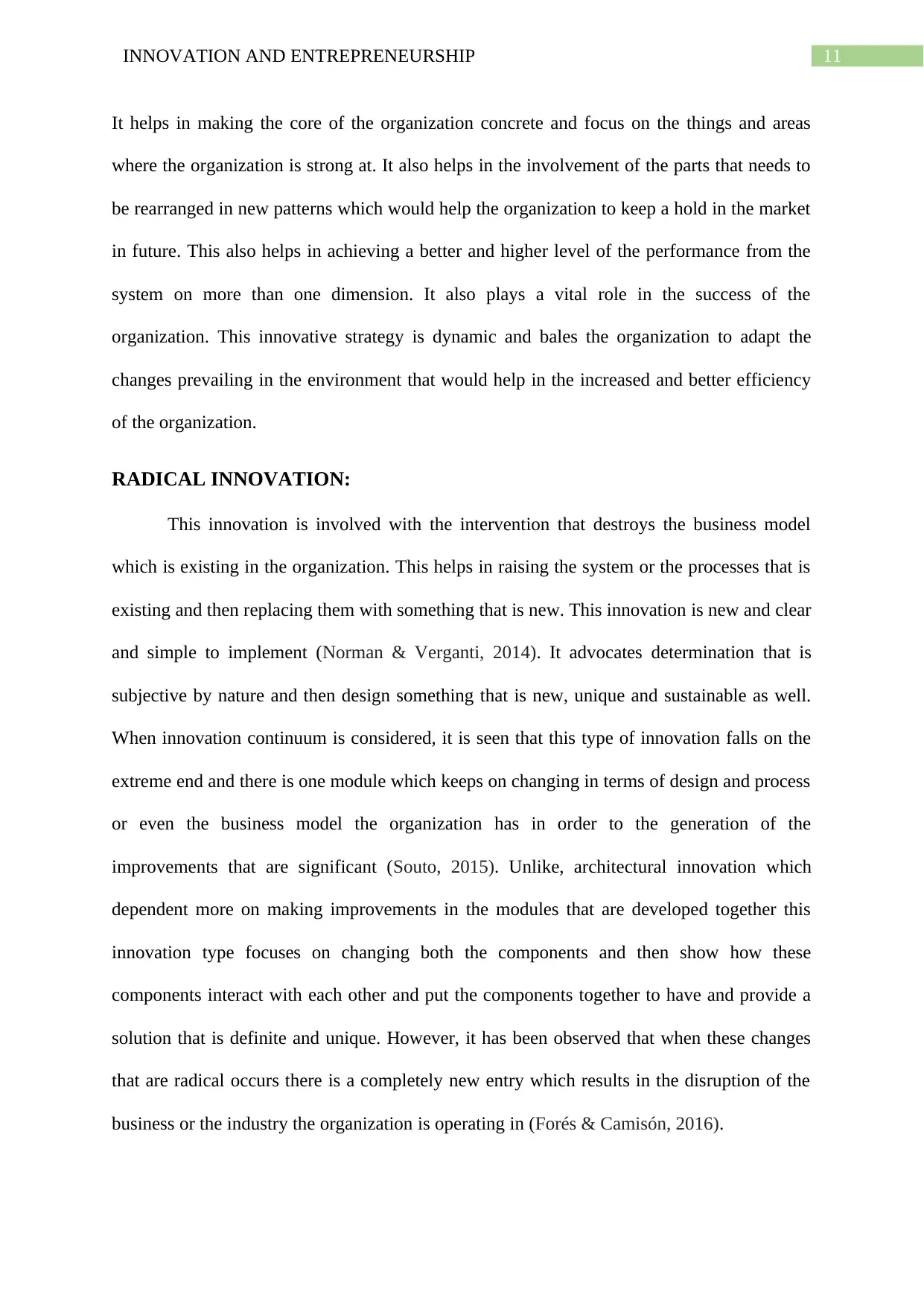
11INNOVATION AND ENTREPRENEURSHIP
It helps in making the core of the organization concrete and focus on the things and areas
where the organization is strong at. It also helps in the involvement of the parts that needs to
be rearranged in new patterns which would help the organization to keep a hold in the market
in future. This also helps in achieving a better and higher level of the performance from the
system on more than one dimension. It also plays a vital role in the success of the
organization. This innovative strategy is dynamic and bales the organization to adapt the
changes prevailing in the environment that would help in the increased and better efficiency
of the organization.
RADICAL INNOVATION:
This innovation is involved with the intervention that destroys the business model
which is existing in the organization. This helps in raising the system or the processes that is
existing and then replacing them with something that is new. This innovation is new and clear
and simple to implement (Norman & Verganti, 2014). It advocates determination that is
subjective by nature and then design something that is new, unique and sustainable as well.
When innovation continuum is considered, it is seen that this type of innovation falls on the
extreme end and there is one module which keeps on changing in terms of design and process
or even the business model the organization has in order to the generation of the
improvements that are significant (Souto, 2015). Unlike, architectural innovation which
dependent more on making improvements in the modules that are developed together this
innovation type focuses on changing both the components and then show how these
components interact with each other and put the components together to have and provide a
solution that is definite and unique. However, it has been observed that when these changes
that are radical occurs there is a completely new entry which results in the disruption of the
business or the industry the organization is operating in (Forés & Camisón, 2016).
It helps in making the core of the organization concrete and focus on the things and areas
where the organization is strong at. It also helps in the involvement of the parts that needs to
be rearranged in new patterns which would help the organization to keep a hold in the market
in future. This also helps in achieving a better and higher level of the performance from the
system on more than one dimension. It also plays a vital role in the success of the
organization. This innovative strategy is dynamic and bales the organization to adapt the
changes prevailing in the environment that would help in the increased and better efficiency
of the organization.
RADICAL INNOVATION:
This innovation is involved with the intervention that destroys the business model
which is existing in the organization. This helps in raising the system or the processes that is
existing and then replacing them with something that is new. This innovation is new and clear
and simple to implement (Norman & Verganti, 2014). It advocates determination that is
subjective by nature and then design something that is new, unique and sustainable as well.
When innovation continuum is considered, it is seen that this type of innovation falls on the
extreme end and there is one module which keeps on changing in terms of design and process
or even the business model the organization has in order to the generation of the
improvements that are significant (Souto, 2015). Unlike, architectural innovation which
dependent more on making improvements in the modules that are developed together this
innovation type focuses on changing both the components and then show how these
components interact with each other and put the components together to have and provide a
solution that is definite and unique. However, it has been observed that when these changes
that are radical occurs there is a completely new entry which results in the disruption of the
business or the industry the organization is operating in (Forés & Camisón, 2016).
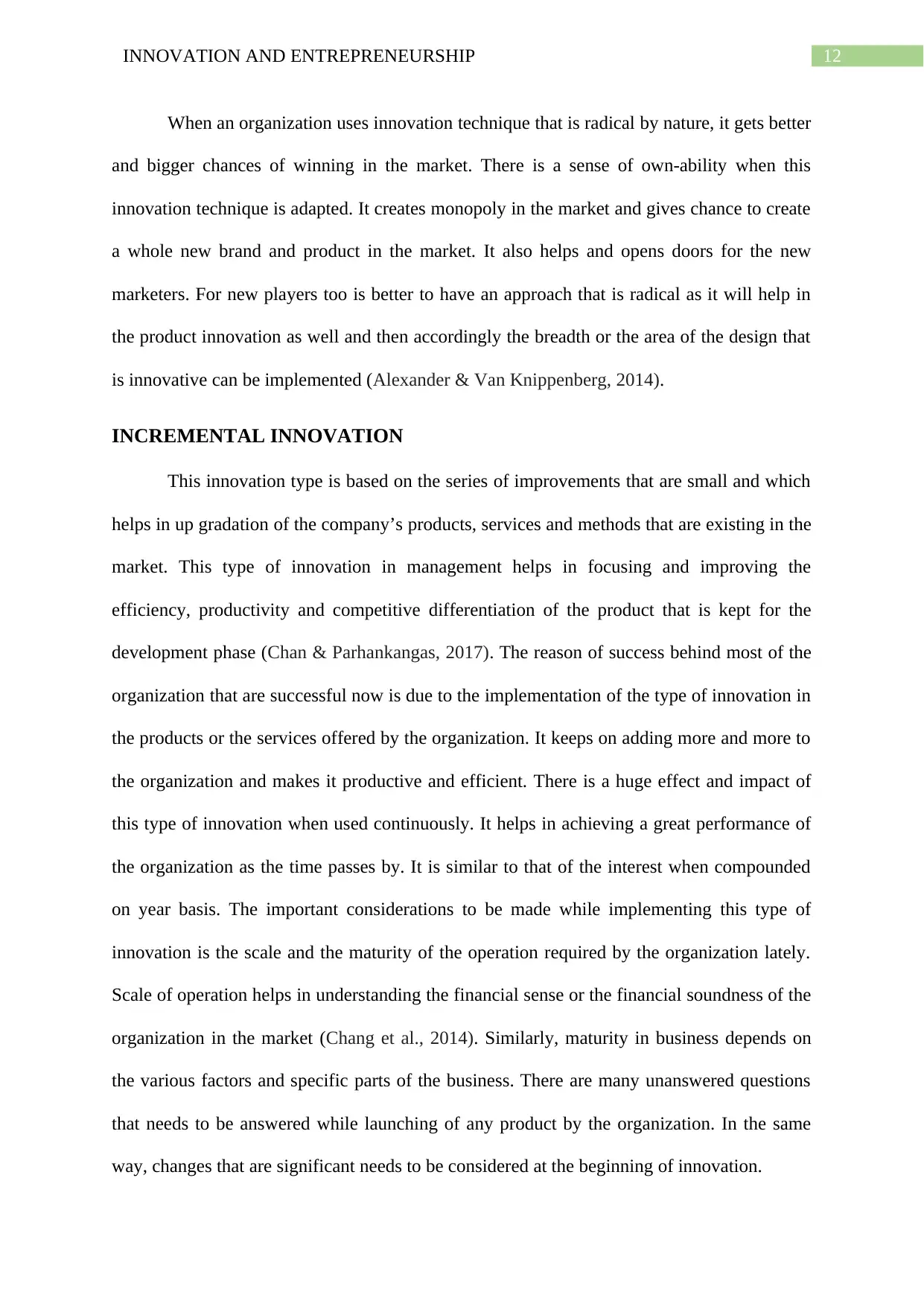
12INNOVATION AND ENTREPRENEURSHIP
When an organization uses innovation technique that is radical by nature, it gets better
and bigger chances of winning in the market. There is a sense of own-ability when this
innovation technique is adapted. It creates monopoly in the market and gives chance to create
a whole new brand and product in the market. It also helps and opens doors for the new
marketers. For new players too is better to have an approach that is radical as it will help in
the product innovation as well and then accordingly the breadth or the area of the design that
is innovative can be implemented (Alexander & Van Knippenberg, 2014).
INCREMENTAL INNOVATION
This innovation type is based on the series of improvements that are small and which
helps in up gradation of the company’s products, services and methods that are existing in the
market. This type of innovation in management helps in focusing and improving the
efficiency, productivity and competitive differentiation of the product that is kept for the
development phase (Chan & Parhankangas, 2017). The reason of success behind most of the
organization that are successful now is due to the implementation of the type of innovation in
the products or the services offered by the organization. It keeps on adding more and more to
the organization and makes it productive and efficient. There is a huge effect and impact of
this type of innovation when used continuously. It helps in achieving a great performance of
the organization as the time passes by. It is similar to that of the interest when compounded
on year basis. The important considerations to be made while implementing this type of
innovation is the scale and the maturity of the operation required by the organization lately.
Scale of operation helps in understanding the financial sense or the financial soundness of the
organization in the market (Chang et al., 2014). Similarly, maturity in business depends on
the various factors and specific parts of the business. There are many unanswered questions
that needs to be answered while launching of any product by the organization. In the same
way, changes that are significant needs to be considered at the beginning of innovation.
When an organization uses innovation technique that is radical by nature, it gets better
and bigger chances of winning in the market. There is a sense of own-ability when this
innovation technique is adapted. It creates monopoly in the market and gives chance to create
a whole new brand and product in the market. It also helps and opens doors for the new
marketers. For new players too is better to have an approach that is radical as it will help in
the product innovation as well and then accordingly the breadth or the area of the design that
is innovative can be implemented (Alexander & Van Knippenberg, 2014).
INCREMENTAL INNOVATION
This innovation type is based on the series of improvements that are small and which
helps in up gradation of the company’s products, services and methods that are existing in the
market. This type of innovation in management helps in focusing and improving the
efficiency, productivity and competitive differentiation of the product that is kept for the
development phase (Chan & Parhankangas, 2017). The reason of success behind most of the
organization that are successful now is due to the implementation of the type of innovation in
the products or the services offered by the organization. It keeps on adding more and more to
the organization and makes it productive and efficient. There is a huge effect and impact of
this type of innovation when used continuously. It helps in achieving a great performance of
the organization as the time passes by. It is similar to that of the interest when compounded
on year basis. The important considerations to be made while implementing this type of
innovation is the scale and the maturity of the operation required by the organization lately.
Scale of operation helps in understanding the financial sense or the financial soundness of the
organization in the market (Chang et al., 2014). Similarly, maturity in business depends on
the various factors and specific parts of the business. There are many unanswered questions
that needs to be answered while launching of any product by the organization. In the same
way, changes that are significant needs to be considered at the beginning of innovation.
Paraphrase This Document
Need a fresh take? Get an instant paraphrase of this document with our AI Paraphraser
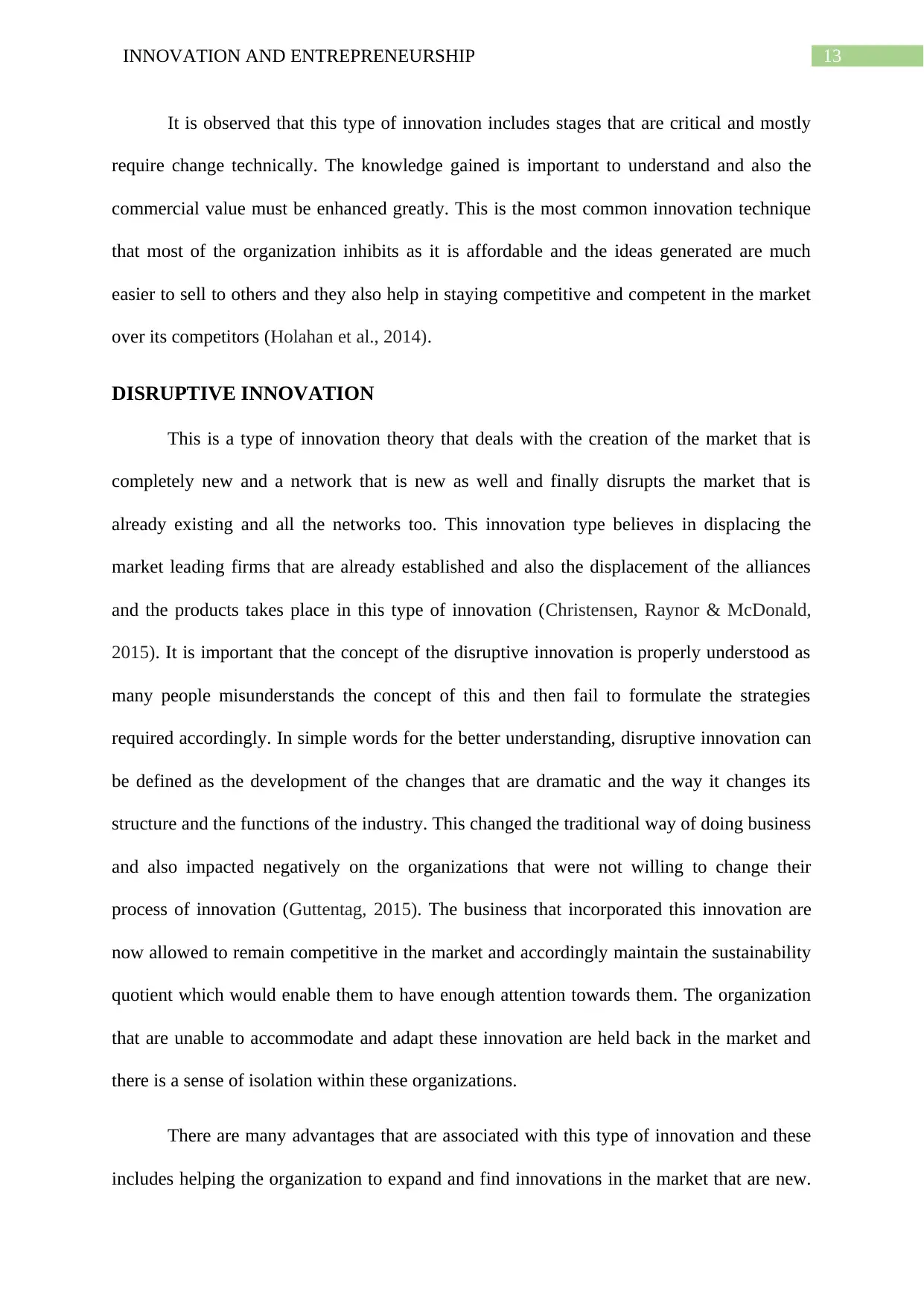
13INNOVATION AND ENTREPRENEURSHIP
It is observed that this type of innovation includes stages that are critical and mostly
require change technically. The knowledge gained is important to understand and also the
commercial value must be enhanced greatly. This is the most common innovation technique
that most of the organization inhibits as it is affordable and the ideas generated are much
easier to sell to others and they also help in staying competitive and competent in the market
over its competitors (Holahan et al., 2014).
DISRUPTIVE INNOVATION
This is a type of innovation theory that deals with the creation of the market that is
completely new and a network that is new as well and finally disrupts the market that is
already existing and all the networks too. This innovation type believes in displacing the
market leading firms that are already established and also the displacement of the alliances
and the products takes place in this type of innovation (Christensen, Raynor & McDonald,
2015). It is important that the concept of the disruptive innovation is properly understood as
many people misunderstands the concept of this and then fail to formulate the strategies
required accordingly. In simple words for the better understanding, disruptive innovation can
be defined as the development of the changes that are dramatic and the way it changes its
structure and the functions of the industry. This changed the traditional way of doing business
and also impacted negatively on the organizations that were not willing to change their
process of innovation (Guttentag, 2015). The business that incorporated this innovation are
now allowed to remain competitive in the market and accordingly maintain the sustainability
quotient which would enable them to have enough attention towards them. The organization
that are unable to accommodate and adapt these innovation are held back in the market and
there is a sense of isolation within these organizations.
There are many advantages that are associated with this type of innovation and these
includes helping the organization to expand and find innovations in the market that are new.
It is observed that this type of innovation includes stages that are critical and mostly
require change technically. The knowledge gained is important to understand and also the
commercial value must be enhanced greatly. This is the most common innovation technique
that most of the organization inhibits as it is affordable and the ideas generated are much
easier to sell to others and they also help in staying competitive and competent in the market
over its competitors (Holahan et al., 2014).
DISRUPTIVE INNOVATION
This is a type of innovation theory that deals with the creation of the market that is
completely new and a network that is new as well and finally disrupts the market that is
already existing and all the networks too. This innovation type believes in displacing the
market leading firms that are already established and also the displacement of the alliances
and the products takes place in this type of innovation (Christensen, Raynor & McDonald,
2015). It is important that the concept of the disruptive innovation is properly understood as
many people misunderstands the concept of this and then fail to formulate the strategies
required accordingly. In simple words for the better understanding, disruptive innovation can
be defined as the development of the changes that are dramatic and the way it changes its
structure and the functions of the industry. This changed the traditional way of doing business
and also impacted negatively on the organizations that were not willing to change their
process of innovation (Guttentag, 2015). The business that incorporated this innovation are
now allowed to remain competitive in the market and accordingly maintain the sustainability
quotient which would enable them to have enough attention towards them. The organization
that are unable to accommodate and adapt these innovation are held back in the market and
there is a sense of isolation within these organizations.
There are many advantages that are associated with this type of innovation and these
includes helping the organization to expand and find innovations in the market that are new.
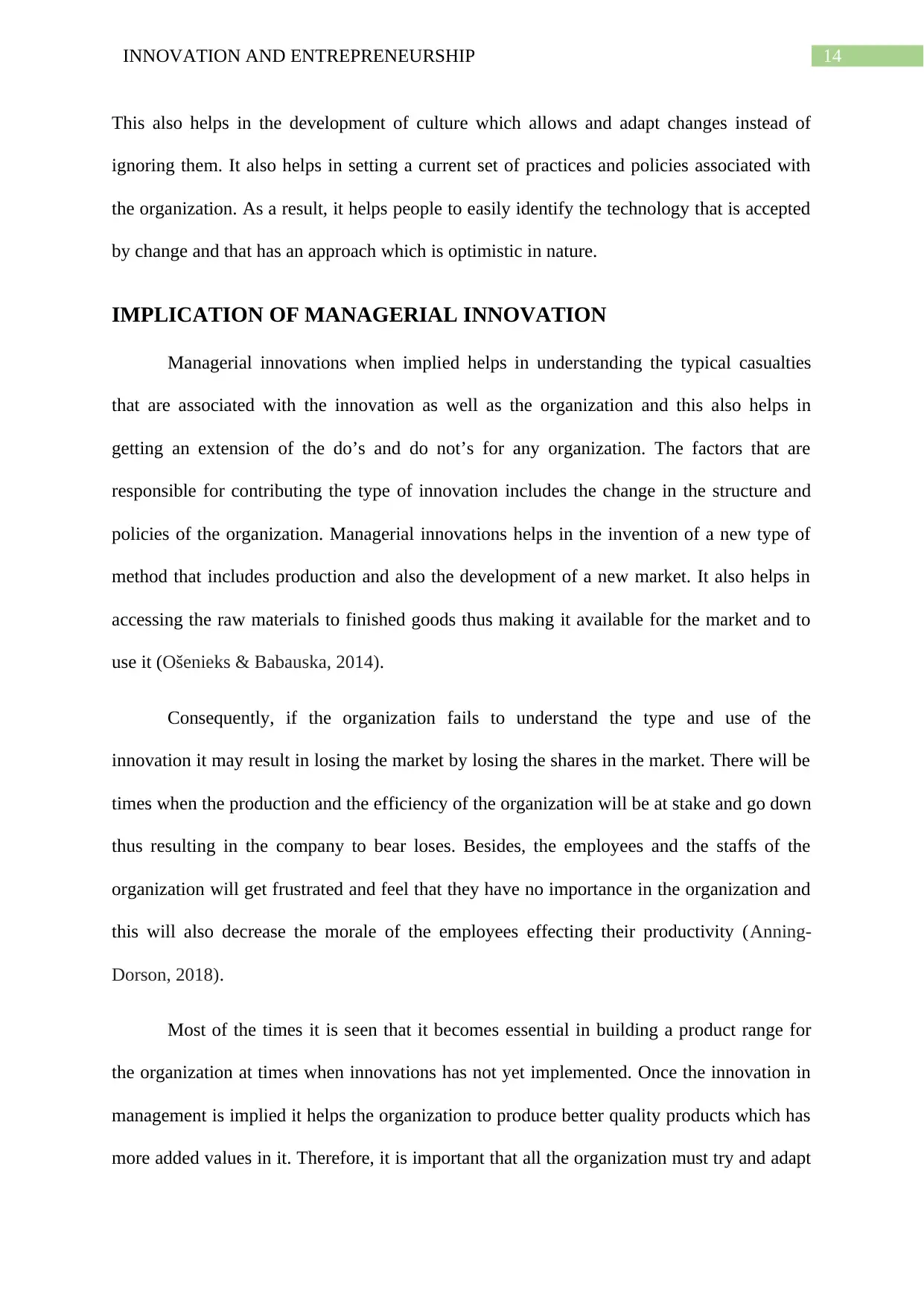
14INNOVATION AND ENTREPRENEURSHIP
This also helps in the development of culture which allows and adapt changes instead of
ignoring them. It also helps in setting a current set of practices and policies associated with
the organization. As a result, it helps people to easily identify the technology that is accepted
by change and that has an approach which is optimistic in nature.
IMPLICATION OF MANAGERIAL INNOVATION
Managerial innovations when implied helps in understanding the typical casualties
that are associated with the innovation as well as the organization and this also helps in
getting an extension of the do’s and do not’s for any organization. The factors that are
responsible for contributing the type of innovation includes the change in the structure and
policies of the organization. Managerial innovations helps in the invention of a new type of
method that includes production and also the development of a new market. It also helps in
accessing the raw materials to finished goods thus making it available for the market and to
use it (Ošenieks & Babauska, 2014).
Consequently, if the organization fails to understand the type and use of the
innovation it may result in losing the market by losing the shares in the market. There will be
times when the production and the efficiency of the organization will be at stake and go down
thus resulting in the company to bear loses. Besides, the employees and the staffs of the
organization will get frustrated and feel that they have no importance in the organization and
this will also decrease the morale of the employees effecting their productivity (Anning-
Dorson, 2018).
Most of the times it is seen that it becomes essential in building a product range for
the organization at times when innovations has not yet implemented. Once the innovation in
management is implied it helps the organization to produce better quality products which has
more added values in it. Therefore, it is important that all the organization must try and adapt
This also helps in the development of culture which allows and adapt changes instead of
ignoring them. It also helps in setting a current set of practices and policies associated with
the organization. As a result, it helps people to easily identify the technology that is accepted
by change and that has an approach which is optimistic in nature.
IMPLICATION OF MANAGERIAL INNOVATION
Managerial innovations when implied helps in understanding the typical casualties
that are associated with the innovation as well as the organization and this also helps in
getting an extension of the do’s and do not’s for any organization. The factors that are
responsible for contributing the type of innovation includes the change in the structure and
policies of the organization. Managerial innovations helps in the invention of a new type of
method that includes production and also the development of a new market. It also helps in
accessing the raw materials to finished goods thus making it available for the market and to
use it (Ošenieks & Babauska, 2014).
Consequently, if the organization fails to understand the type and use of the
innovation it may result in losing the market by losing the shares in the market. There will be
times when the production and the efficiency of the organization will be at stake and go down
thus resulting in the company to bear loses. Besides, the employees and the staffs of the
organization will get frustrated and feel that they have no importance in the organization and
this will also decrease the morale of the employees effecting their productivity (Anning-
Dorson, 2018).
Most of the times it is seen that it becomes essential in building a product range for
the organization at times when innovations has not yet implemented. Once the innovation in
management is implied it helps the organization to produce better quality products which has
more added values in it. Therefore, it is important that all the organization must try and adapt
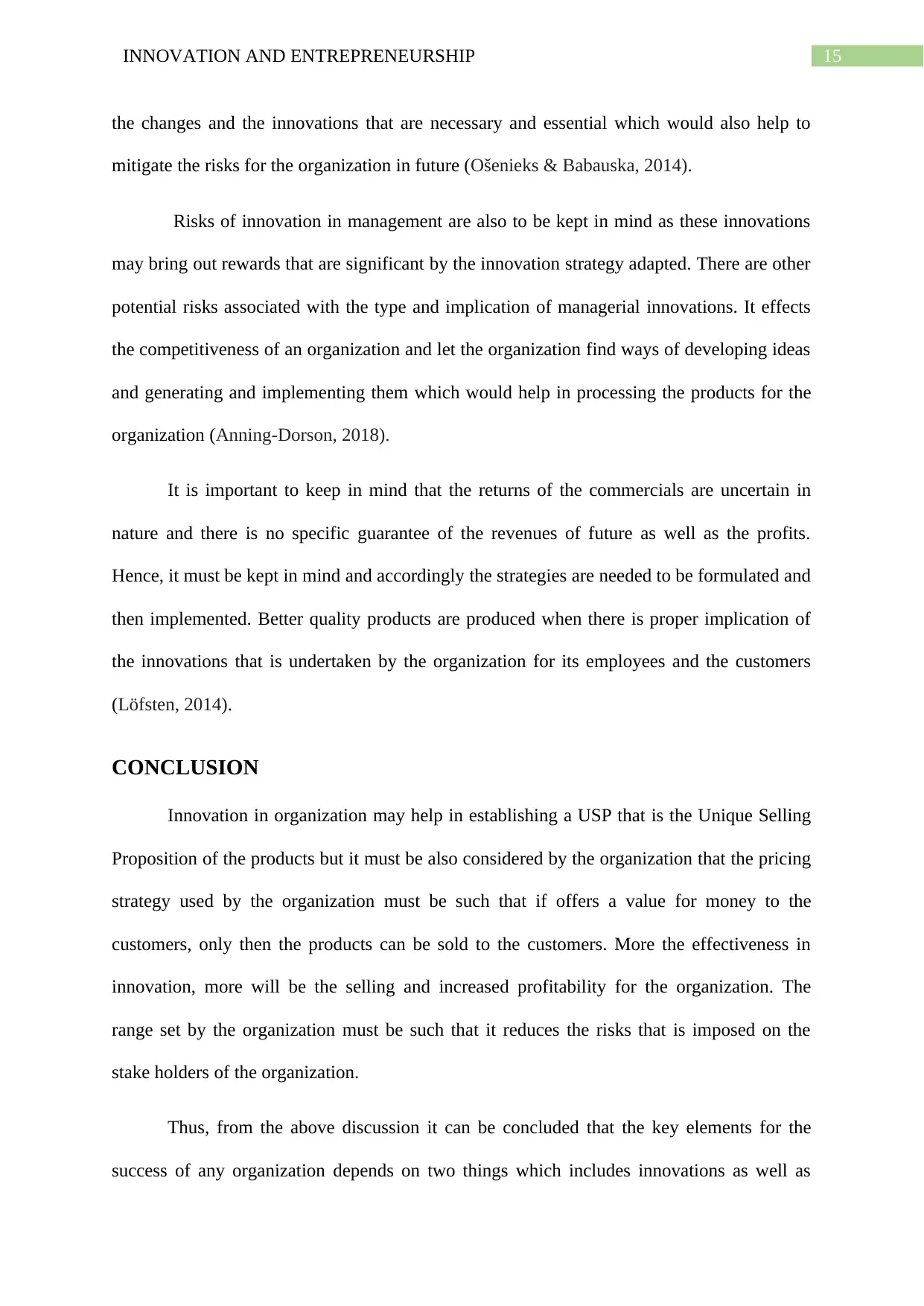
15INNOVATION AND ENTREPRENEURSHIP
the changes and the innovations that are necessary and essential which would also help to
mitigate the risks for the organization in future (Ošenieks & Babauska, 2014).
Risks of innovation in management are also to be kept in mind as these innovations
may bring out rewards that are significant by the innovation strategy adapted. There are other
potential risks associated with the type and implication of managerial innovations. It effects
the competitiveness of an organization and let the organization find ways of developing ideas
and generating and implementing them which would help in processing the products for the
organization (Anning-Dorson, 2018).
It is important to keep in mind that the returns of the commercials are uncertain in
nature and there is no specific guarantee of the revenues of future as well as the profits.
Hence, it must be kept in mind and accordingly the strategies are needed to be formulated and
then implemented. Better quality products are produced when there is proper implication of
the innovations that is undertaken by the organization for its employees and the customers
(Löfsten, 2014).
CONCLUSION
Innovation in organization may help in establishing a USP that is the Unique Selling
Proposition of the products but it must be also considered by the organization that the pricing
strategy used by the organization must be such that if offers a value for money to the
customers, only then the products can be sold to the customers. More the effectiveness in
innovation, more will be the selling and increased profitability for the organization. The
range set by the organization must be such that it reduces the risks that is imposed on the
stake holders of the organization.
Thus, from the above discussion it can be concluded that the key elements for the
success of any organization depends on two things which includes innovations as well as
the changes and the innovations that are necessary and essential which would also help to
mitigate the risks for the organization in future (Ošenieks & Babauska, 2014).
Risks of innovation in management are also to be kept in mind as these innovations
may bring out rewards that are significant by the innovation strategy adapted. There are other
potential risks associated with the type and implication of managerial innovations. It effects
the competitiveness of an organization and let the organization find ways of developing ideas
and generating and implementing them which would help in processing the products for the
organization (Anning-Dorson, 2018).
It is important to keep in mind that the returns of the commercials are uncertain in
nature and there is no specific guarantee of the revenues of future as well as the profits.
Hence, it must be kept in mind and accordingly the strategies are needed to be formulated and
then implemented. Better quality products are produced when there is proper implication of
the innovations that is undertaken by the organization for its employees and the customers
(Löfsten, 2014).
CONCLUSION
Innovation in organization may help in establishing a USP that is the Unique Selling
Proposition of the products but it must be also considered by the organization that the pricing
strategy used by the organization must be such that if offers a value for money to the
customers, only then the products can be sold to the customers. More the effectiveness in
innovation, more will be the selling and increased profitability for the organization. The
range set by the organization must be such that it reduces the risks that is imposed on the
stake holders of the organization.
Thus, from the above discussion it can be concluded that the key elements for the
success of any organization depends on two things which includes innovations as well as
Secure Best Marks with AI Grader
Need help grading? Try our AI Grader for instant feedback on your assignments.
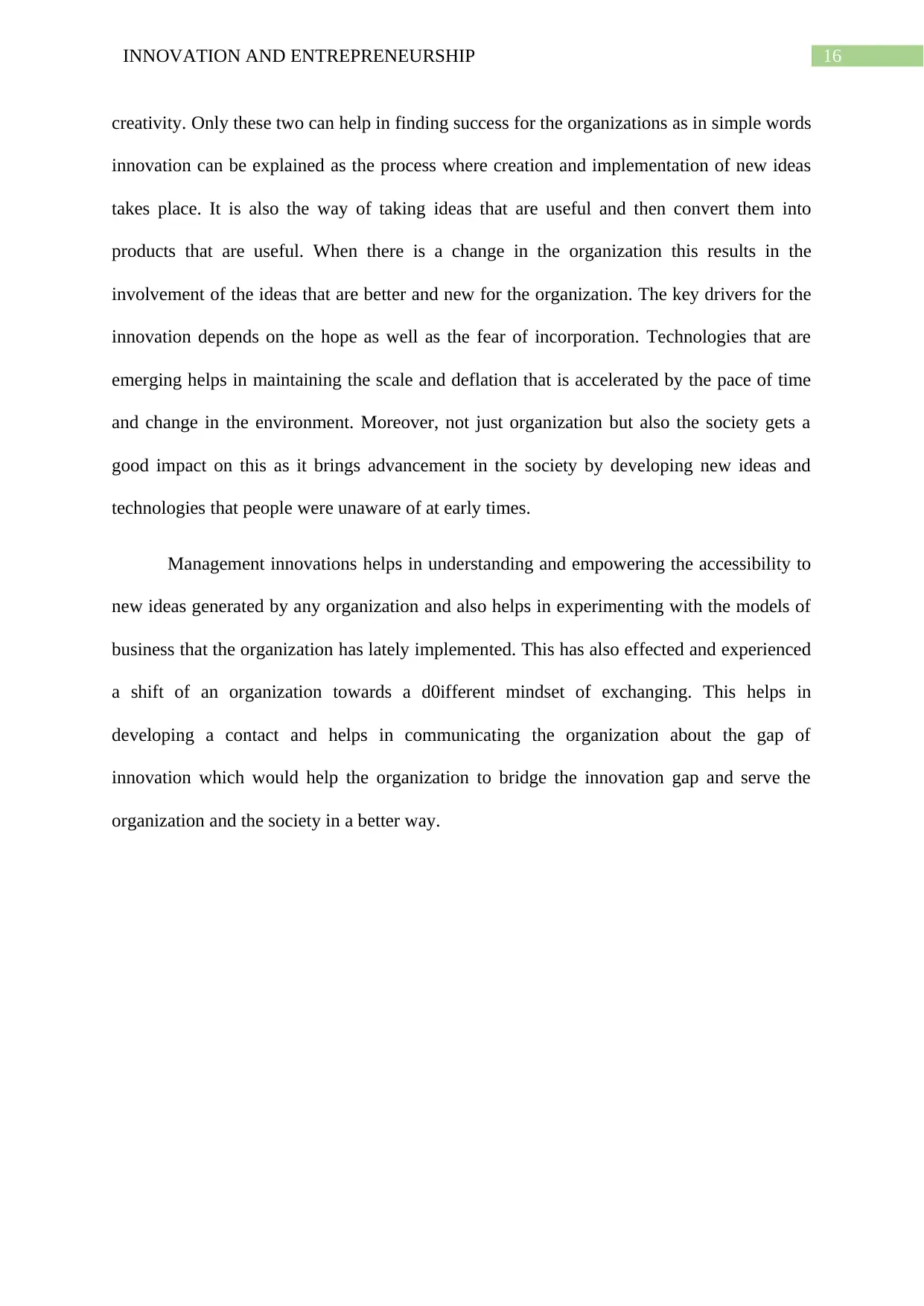
16INNOVATION AND ENTREPRENEURSHIP
creativity. Only these two can help in finding success for the organizations as in simple words
innovation can be explained as the process where creation and implementation of new ideas
takes place. It is also the way of taking ideas that are useful and then convert them into
products that are useful. When there is a change in the organization this results in the
involvement of the ideas that are better and new for the organization. The key drivers for the
innovation depends on the hope as well as the fear of incorporation. Technologies that are
emerging helps in maintaining the scale and deflation that is accelerated by the pace of time
and change in the environment. Moreover, not just organization but also the society gets a
good impact on this as it brings advancement in the society by developing new ideas and
technologies that people were unaware of at early times.
Management innovations helps in understanding and empowering the accessibility to
new ideas generated by any organization and also helps in experimenting with the models of
business that the organization has lately implemented. This has also effected and experienced
a shift of an organization towards a d0ifferent mindset of exchanging. This helps in
developing a contact and helps in communicating the organization about the gap of
innovation which would help the organization to bridge the innovation gap and serve the
organization and the society in a better way.
creativity. Only these two can help in finding success for the organizations as in simple words
innovation can be explained as the process where creation and implementation of new ideas
takes place. It is also the way of taking ideas that are useful and then convert them into
products that are useful. When there is a change in the organization this results in the
involvement of the ideas that are better and new for the organization. The key drivers for the
innovation depends on the hope as well as the fear of incorporation. Technologies that are
emerging helps in maintaining the scale and deflation that is accelerated by the pace of time
and change in the environment. Moreover, not just organization but also the society gets a
good impact on this as it brings advancement in the society by developing new ideas and
technologies that people were unaware of at early times.
Management innovations helps in understanding and empowering the accessibility to
new ideas generated by any organization and also helps in experimenting with the models of
business that the organization has lately implemented. This has also effected and experienced
a shift of an organization towards a d0ifferent mindset of exchanging. This helps in
developing a contact and helps in communicating the organization about the gap of
innovation which would help the organization to bridge the innovation gap and serve the
organization and the society in a better way.
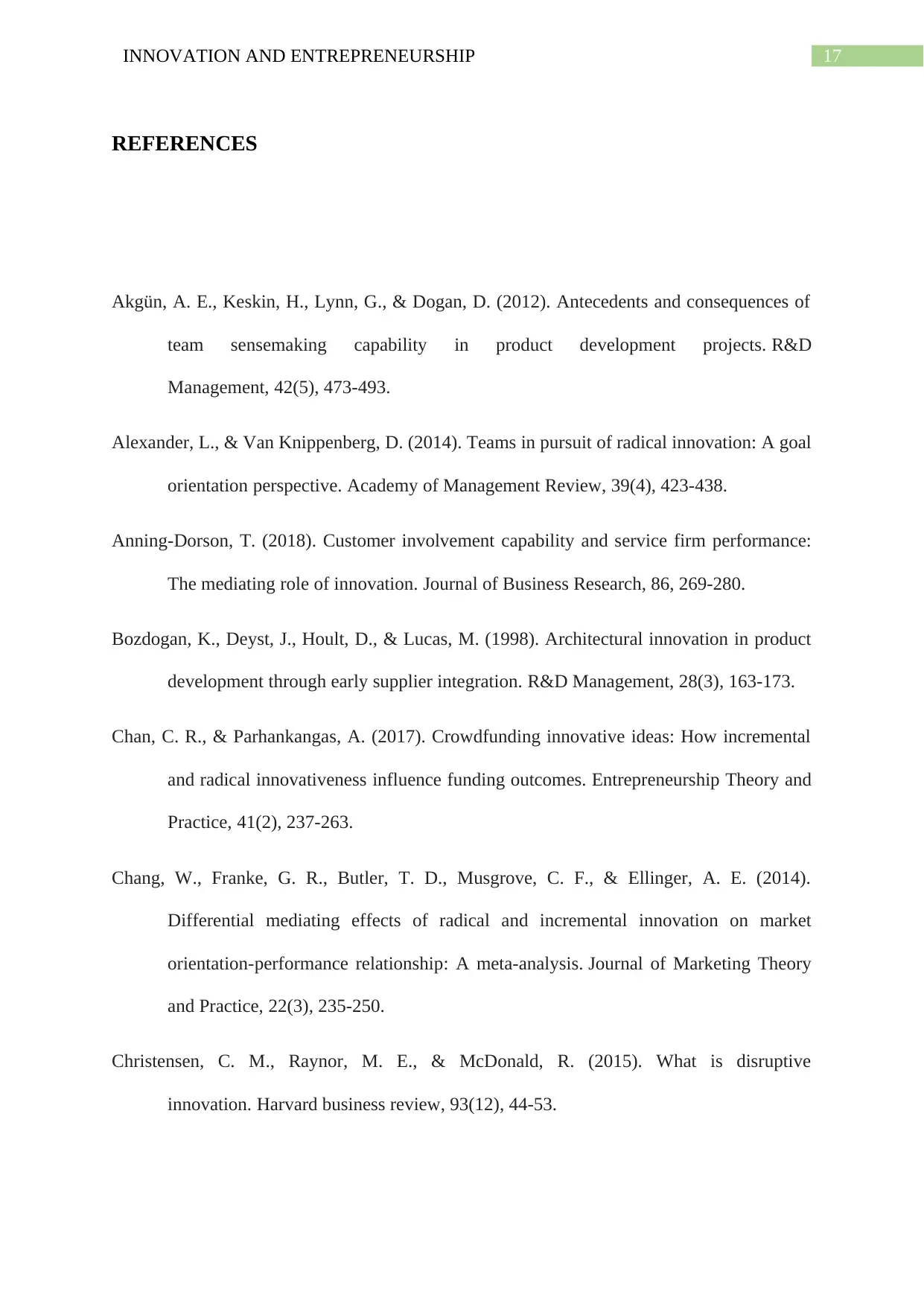
17INNOVATION AND ENTREPRENEURSHIP
REFERENCES
Akgün, A. E., Keskin, H., Lynn, G., & Dogan, D. (2012). Antecedents and consequences of
team sensemaking capability in product development projects. R&D
Management, 42(5), 473-493.
Alexander, L., & Van Knippenberg, D. (2014). Teams in pursuit of radical innovation: A goal
orientation perspective. Academy of Management Review, 39(4), 423-438.
Anning-Dorson, T. (2018). Customer involvement capability and service firm performance:
The mediating role of innovation. Journal of Business Research, 86, 269-280.
Bozdogan, K., Deyst, J., Hoult, D., & Lucas, M. (1998). Architectural innovation in product
development through early supplier integration. R&D Management, 28(3), 163-173.
Chan, C. R., & Parhankangas, A. (2017). Crowdfunding innovative ideas: How incremental
and radical innovativeness influence funding outcomes. Entrepreneurship Theory and
Practice, 41(2), 237-263.
Chang, W., Franke, G. R., Butler, T. D., Musgrove, C. F., & Ellinger, A. E. (2014).
Differential mediating effects of radical and incremental innovation on market
orientation-performance relationship: A meta-analysis. Journal of Marketing Theory
and Practice, 22(3), 235-250.
Christensen, C. M., Raynor, M. E., & McDonald, R. (2015). What is disruptive
innovation. Harvard business review, 93(12), 44-53.
REFERENCES
Akgün, A. E., Keskin, H., Lynn, G., & Dogan, D. (2012). Antecedents and consequences of
team sensemaking capability in product development projects. R&D
Management, 42(5), 473-493.
Alexander, L., & Van Knippenberg, D. (2014). Teams in pursuit of radical innovation: A goal
orientation perspective. Academy of Management Review, 39(4), 423-438.
Anning-Dorson, T. (2018). Customer involvement capability and service firm performance:
The mediating role of innovation. Journal of Business Research, 86, 269-280.
Bozdogan, K., Deyst, J., Hoult, D., & Lucas, M. (1998). Architectural innovation in product
development through early supplier integration. R&D Management, 28(3), 163-173.
Chan, C. R., & Parhankangas, A. (2017). Crowdfunding innovative ideas: How incremental
and radical innovativeness influence funding outcomes. Entrepreneurship Theory and
Practice, 41(2), 237-263.
Chang, W., Franke, G. R., Butler, T. D., Musgrove, C. F., & Ellinger, A. E. (2014).
Differential mediating effects of radical and incremental innovation on market
orientation-performance relationship: A meta-analysis. Journal of Marketing Theory
and Practice, 22(3), 235-250.
Christensen, C. M., Raynor, M. E., & McDonald, R. (2015). What is disruptive
innovation. Harvard business review, 93(12), 44-53.
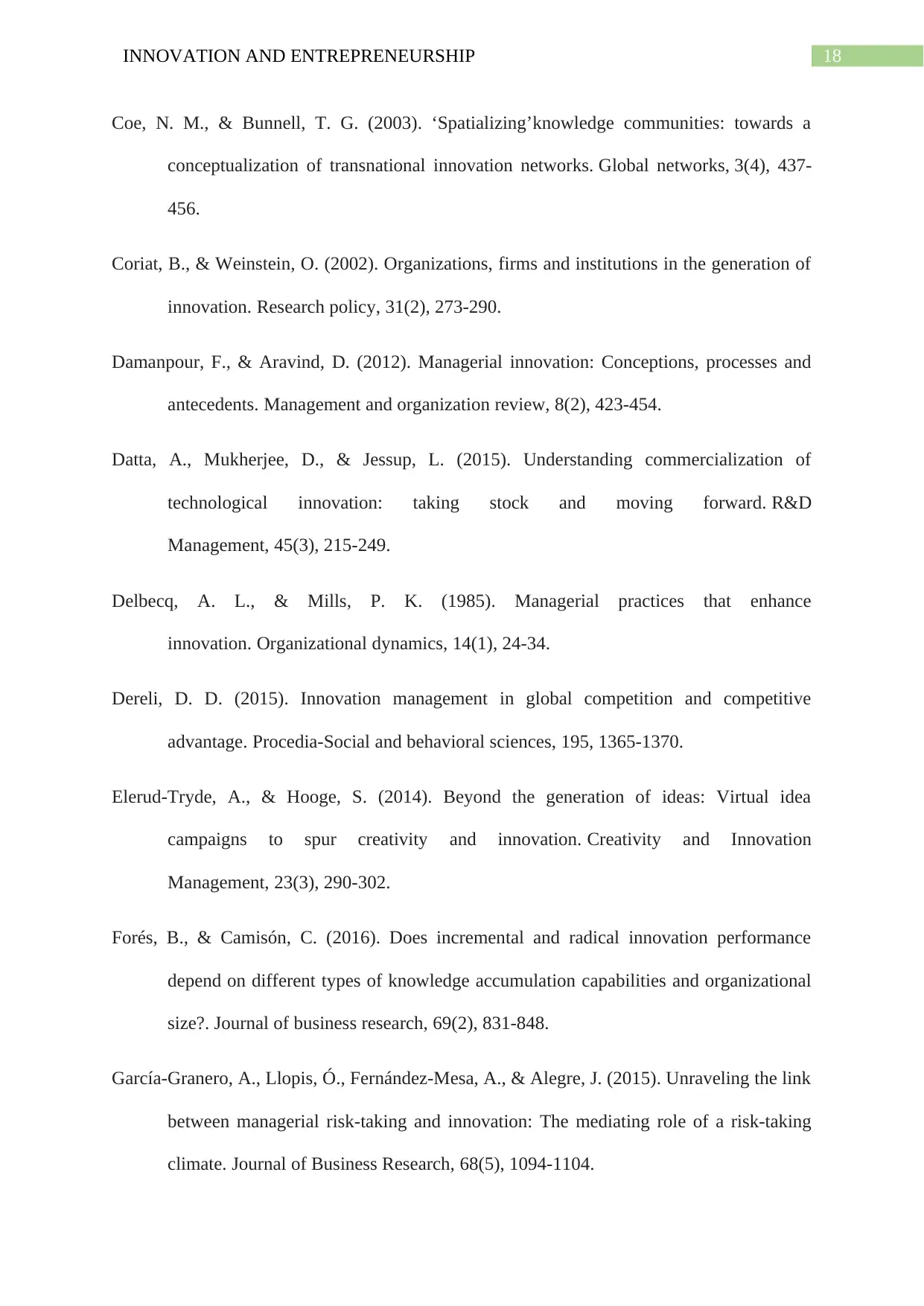
18INNOVATION AND ENTREPRENEURSHIP
Coe, N. M., & Bunnell, T. G. (2003). ‘Spatializing’knowledge communities: towards a
conceptualization of transnational innovation networks. Global networks, 3(4), 437-
456.
Coriat, B., & Weinstein, O. (2002). Organizations, firms and institutions in the generation of
innovation. Research policy, 31(2), 273-290.
Damanpour, F., & Aravind, D. (2012). Managerial innovation: Conceptions, processes and
antecedents. Management and organization review, 8(2), 423-454.
Datta, A., Mukherjee, D., & Jessup, L. (2015). Understanding commercialization of
technological innovation: taking stock and moving forward. R&D
Management, 45(3), 215-249.
Delbecq, A. L., & Mills, P. K. (1985). Managerial practices that enhance
innovation. Organizational dynamics, 14(1), 24-34.
Dereli, D. D. (2015). Innovation management in global competition and competitive
advantage. Procedia-Social and behavioral sciences, 195, 1365-1370.
Elerud‐Tryde, A., & Hooge, S. (2014). Beyond the generation of ideas: Virtual idea
campaigns to spur creativity and innovation. Creativity and Innovation
Management, 23(3), 290-302.
Forés, B., & Camisón, C. (2016). Does incremental and radical innovation performance
depend on different types of knowledge accumulation capabilities and organizational
size?. Journal of business research, 69(2), 831-848.
García-Granero, A., Llopis, Ó., Fernández-Mesa, A., & Alegre, J. (2015). Unraveling the link
between managerial risk-taking and innovation: The mediating role of a risk-taking
climate. Journal of Business Research, 68(5), 1094-1104.
Coe, N. M., & Bunnell, T. G. (2003). ‘Spatializing’knowledge communities: towards a
conceptualization of transnational innovation networks. Global networks, 3(4), 437-
456.
Coriat, B., & Weinstein, O. (2002). Organizations, firms and institutions in the generation of
innovation. Research policy, 31(2), 273-290.
Damanpour, F., & Aravind, D. (2012). Managerial innovation: Conceptions, processes and
antecedents. Management and organization review, 8(2), 423-454.
Datta, A., Mukherjee, D., & Jessup, L. (2015). Understanding commercialization of
technological innovation: taking stock and moving forward. R&D
Management, 45(3), 215-249.
Delbecq, A. L., & Mills, P. K. (1985). Managerial practices that enhance
innovation. Organizational dynamics, 14(1), 24-34.
Dereli, D. D. (2015). Innovation management in global competition and competitive
advantage. Procedia-Social and behavioral sciences, 195, 1365-1370.
Elerud‐Tryde, A., & Hooge, S. (2014). Beyond the generation of ideas: Virtual idea
campaigns to spur creativity and innovation. Creativity and Innovation
Management, 23(3), 290-302.
Forés, B., & Camisón, C. (2016). Does incremental and radical innovation performance
depend on different types of knowledge accumulation capabilities and organizational
size?. Journal of business research, 69(2), 831-848.
García-Granero, A., Llopis, Ó., Fernández-Mesa, A., & Alegre, J. (2015). Unraveling the link
between managerial risk-taking and innovation: The mediating role of a risk-taking
climate. Journal of Business Research, 68(5), 1094-1104.
Paraphrase This Document
Need a fresh take? Get an instant paraphrase of this document with our AI Paraphraser
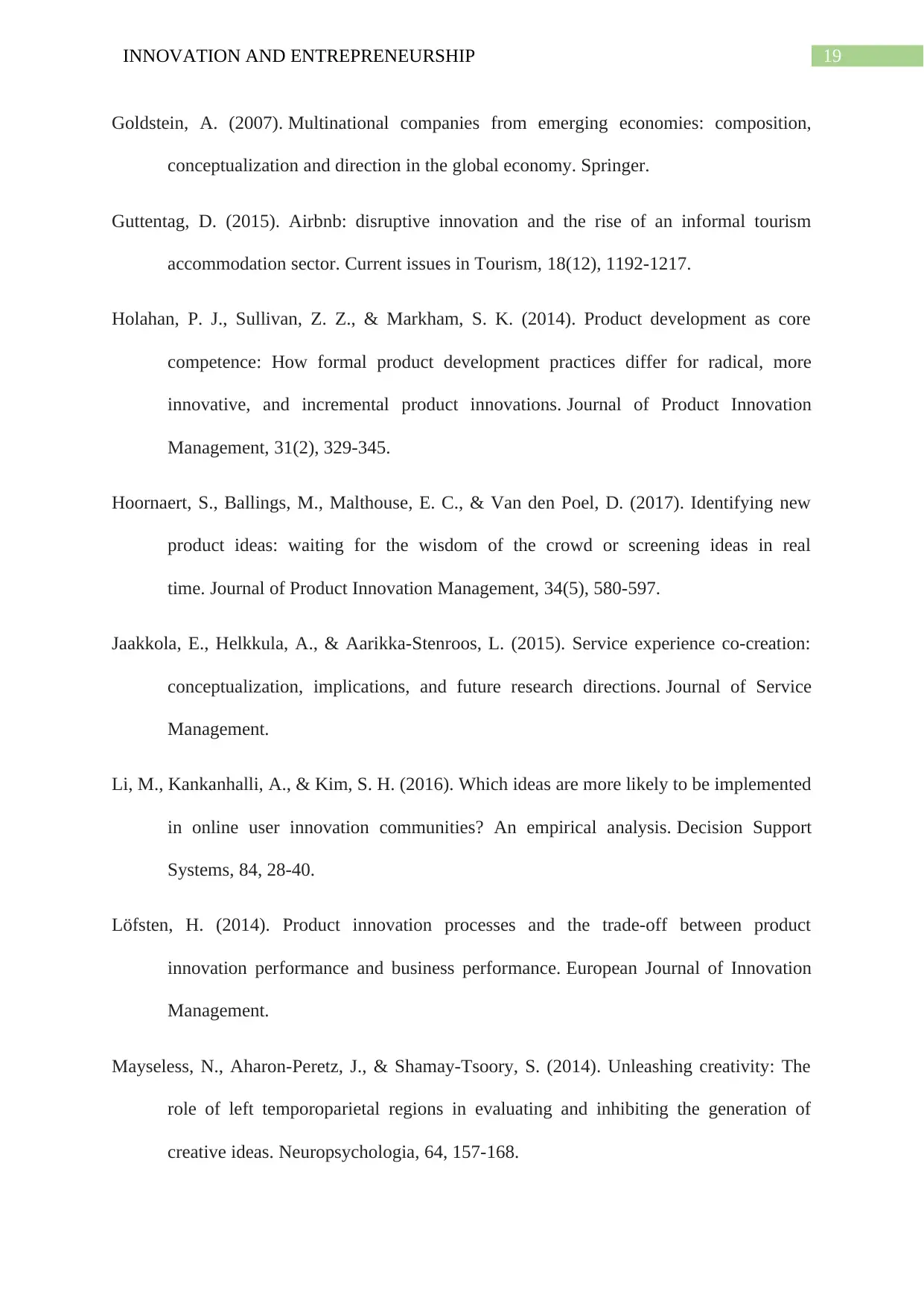
19INNOVATION AND ENTREPRENEURSHIP
Goldstein, A. (2007). Multinational companies from emerging economies: composition,
conceptualization and direction in the global economy. Springer.
Guttentag, D. (2015). Airbnb: disruptive innovation and the rise of an informal tourism
accommodation sector. Current issues in Tourism, 18(12), 1192-1217.
Holahan, P. J., Sullivan, Z. Z., & Markham, S. K. (2014). Product development as core
competence: How formal product development practices differ for radical, more
innovative, and incremental product innovations. Journal of Product Innovation
Management, 31(2), 329-345.
Hoornaert, S., Ballings, M., Malthouse, E. C., & Van den Poel, D. (2017). Identifying new
product ideas: waiting for the wisdom of the crowd or screening ideas in real
time. Journal of Product Innovation Management, 34(5), 580-597.
Jaakkola, E., Helkkula, A., & Aarikka-Stenroos, L. (2015). Service experience co-creation:
conceptualization, implications, and future research directions. Journal of Service
Management.
Li, M., Kankanhalli, A., & Kim, S. H. (2016). Which ideas are more likely to be implemented
in online user innovation communities? An empirical analysis. Decision Support
Systems, 84, 28-40.
Löfsten, H. (2014). Product innovation processes and the trade-off between product
innovation performance and business performance. European Journal of Innovation
Management.
Mayseless, N., Aharon-Peretz, J., & Shamay-Tsoory, S. (2014). Unleashing creativity: The
role of left temporoparietal regions in evaluating and inhibiting the generation of
creative ideas. Neuropsychologia, 64, 157-168.
Goldstein, A. (2007). Multinational companies from emerging economies: composition,
conceptualization and direction in the global economy. Springer.
Guttentag, D. (2015). Airbnb: disruptive innovation and the rise of an informal tourism
accommodation sector. Current issues in Tourism, 18(12), 1192-1217.
Holahan, P. J., Sullivan, Z. Z., & Markham, S. K. (2014). Product development as core
competence: How formal product development practices differ for radical, more
innovative, and incremental product innovations. Journal of Product Innovation
Management, 31(2), 329-345.
Hoornaert, S., Ballings, M., Malthouse, E. C., & Van den Poel, D. (2017). Identifying new
product ideas: waiting for the wisdom of the crowd or screening ideas in real
time. Journal of Product Innovation Management, 34(5), 580-597.
Jaakkola, E., Helkkula, A., & Aarikka-Stenroos, L. (2015). Service experience co-creation:
conceptualization, implications, and future research directions. Journal of Service
Management.
Li, M., Kankanhalli, A., & Kim, S. H. (2016). Which ideas are more likely to be implemented
in online user innovation communities? An empirical analysis. Decision Support
Systems, 84, 28-40.
Löfsten, H. (2014). Product innovation processes and the trade-off between product
innovation performance and business performance. European Journal of Innovation
Management.
Mayseless, N., Aharon-Peretz, J., & Shamay-Tsoory, S. (2014). Unleashing creativity: The
role of left temporoparietal regions in evaluating and inhibiting the generation of
creative ideas. Neuropsychologia, 64, 157-168.
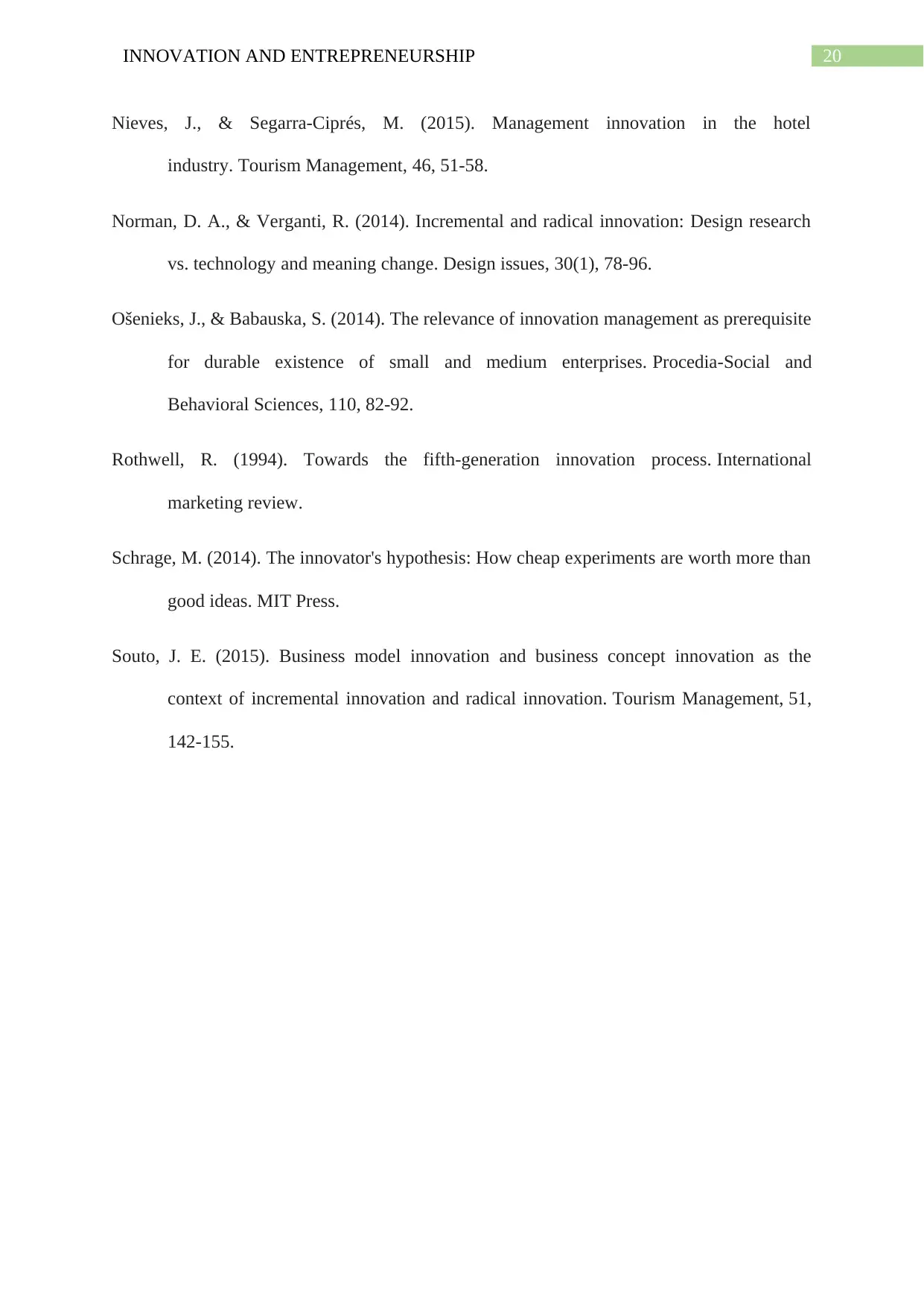
20INNOVATION AND ENTREPRENEURSHIP
Nieves, J., & Segarra-Ciprés, M. (2015). Management innovation in the hotel
industry. Tourism Management, 46, 51-58.
Norman, D. A., & Verganti, R. (2014). Incremental and radical innovation: Design research
vs. technology and meaning change. Design issues, 30(1), 78-96.
Ošenieks, J., & Babauska, S. (2014). The relevance of innovation management as prerequisite
for durable existence of small and medium enterprises. Procedia-Social and
Behavioral Sciences, 110, 82-92.
Rothwell, R. (1994). Towards the fifth‐generation innovation process. International
marketing review.
Schrage, M. (2014). The innovator's hypothesis: How cheap experiments are worth more than
good ideas. MIT Press.
Souto, J. E. (2015). Business model innovation and business concept innovation as the
context of incremental innovation and radical innovation. Tourism Management, 51,
142-155.
Nieves, J., & Segarra-Ciprés, M. (2015). Management innovation in the hotel
industry. Tourism Management, 46, 51-58.
Norman, D. A., & Verganti, R. (2014). Incremental and radical innovation: Design research
vs. technology and meaning change. Design issues, 30(1), 78-96.
Ošenieks, J., & Babauska, S. (2014). The relevance of innovation management as prerequisite
for durable existence of small and medium enterprises. Procedia-Social and
Behavioral Sciences, 110, 82-92.
Rothwell, R. (1994). Towards the fifth‐generation innovation process. International
marketing review.
Schrage, M. (2014). The innovator's hypothesis: How cheap experiments are worth more than
good ideas. MIT Press.
Souto, J. E. (2015). Business model innovation and business concept innovation as the
context of incremental innovation and radical innovation. Tourism Management, 51,
142-155.
1 out of 21
Related Documents
Your All-in-One AI-Powered Toolkit for Academic Success.
+13062052269
info@desklib.com
Available 24*7 on WhatsApp / Email
![[object Object]](/_next/static/media/star-bottom.7253800d.svg)
Unlock your academic potential
© 2024 | Zucol Services PVT LTD | All rights reserved.





